|
This page describes my beekeeping adventures in 2021. |

|
This page describes my beekeeping adventures in 2021. |

|
I put boardman entrance feeders at each hive.
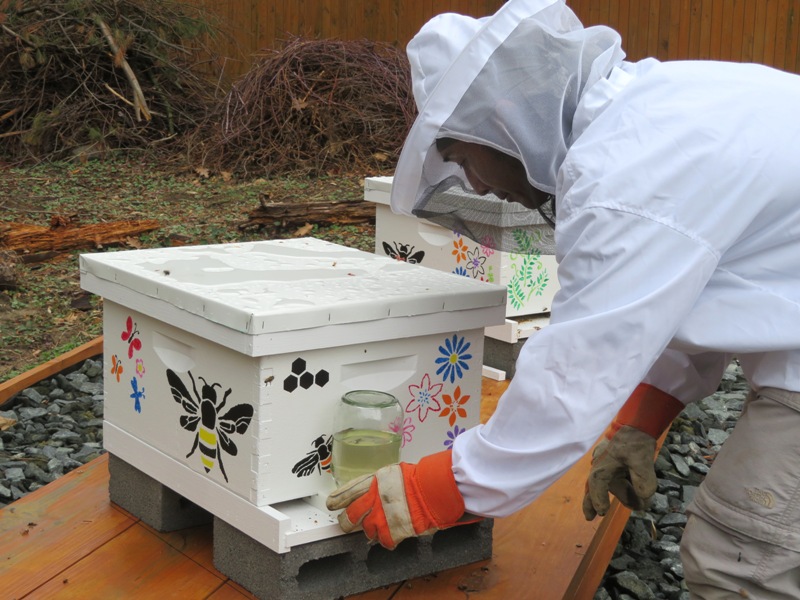
This feeds the bees a sugar water mixture that Norma made using equal parts sugar and water (1:1 ratio). Along with the pollen patties, this should help ensure a strong hive. 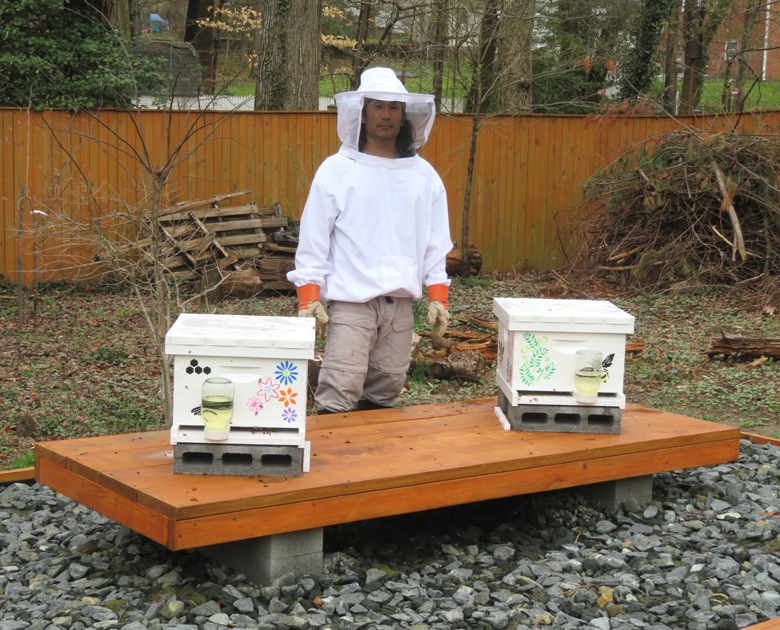
 |

|
I was supposed to check the hives around day four, which was April 1, 2021. March 31 called for a lot of rain. In the days after that, the temperature would drop to highs below 50.
So what's the best hive inspection temperature? Ideally you need to wait until temperatures reach 60 degrees (Fahrenheit) or more before working your beehives. The best time to inspect a hive is when the bees are out foraging. Bees cannot fly when the temperature drops to around 50 degrees and honey bees are rarely out of the hive when the temperature is too hot such as above 100 degrees. So a good rule of thumb for inspections is to aim for temperatures between 60 and 100 degrees. - from Beekeeping Insider - What's the Ideal Hive Inspection Temperature? It turns out it wasn't supposed to rain on March 31, 2021 until mid-morning. So I took advantage of the 62 degree temperature at 0850 and opened the hives. This was my first solo hive inspection. Recall that when we introduced the bees to the hives on March 28, 2021, we replaced the queen in the south hive. This was done by introducing a small cage containing a new queen. She wouldn't be released immediately...it would take a few days for the workers to eat through the candy door to free her. In the meantime, they would become accustomed to her scent and accept her as their new queen. So my first priority was to ensure that she was indeed released. After suiting up, I got the smoker started. This was a learning experience. I'd get it started in the garage, smoke would come out, and after I got it down to the hives, it would die. So I'd go back to the garage and start the process over again. Following a couple iterations of this, I just brought my box of pine needles, lighter, and ignition paper down to the hive. Lesson learned: don't put too much faith in fire. I opened up the south hive and pulled out frames. I made good use of the frame holder that Brian gave me. If I put one side of the frame on the hive (so I could take a picture), I ended up crushing the bees that were underneathe. But the frame holder prevented that. It holds up to three frames. Beyond that, I just cycle them back into the hive. No need to have more than three out at once. 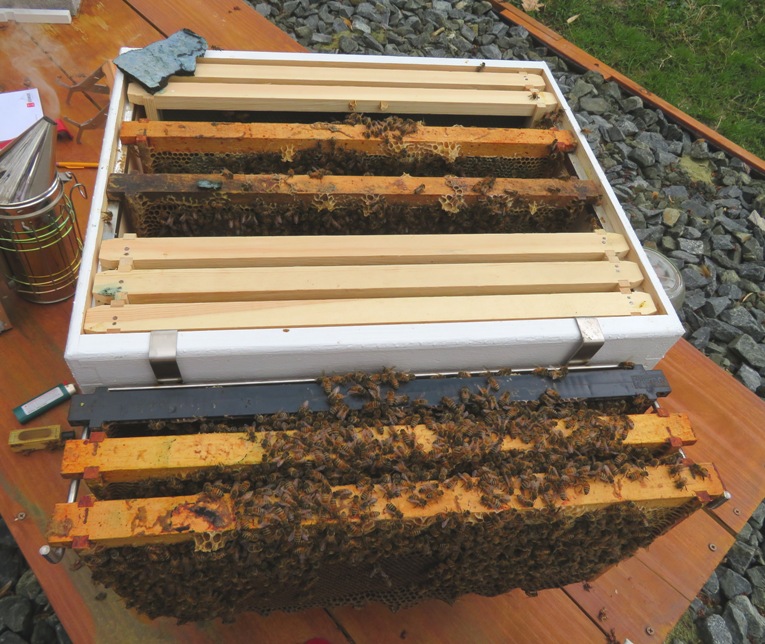
Notice the pollen patty in the above photo. It was much larger three days ago. Next, I located the queen cage. It was clear that the workers had freed her. 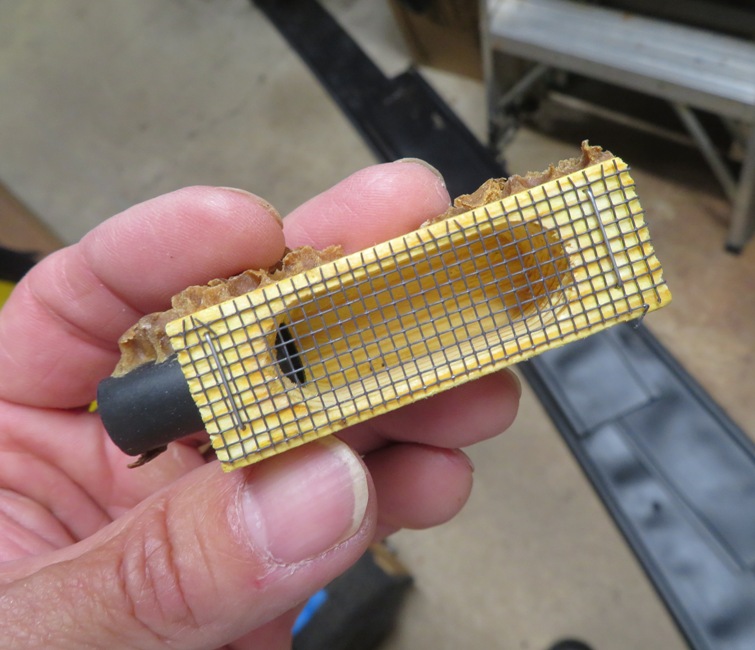
Isnpecting the frames, I did not find any eggs. Was this unusual? No. Recall that three days ago, the old queen was removed. So there was nobody to lay eggs between then and now. The new queen could have been released very recently and might not have had a chance to lay eggs. What is the worker honeybee lifecycle? One concern is that I also did not see larva but considering that the old queen was not in the best of shape, maybe her egg production had dropped before I brought her home. Or maybe there were larva and I just didn't see them. Since I was working alone and slowly, I didn't want to keep the bees out of the hive for too long. I certainly didn't want them to be out if it started raining. So my inspection was not terribly thorough. Lots of bees. Is the stuff in the upper part of this frame brood or honey? I'm still learning. 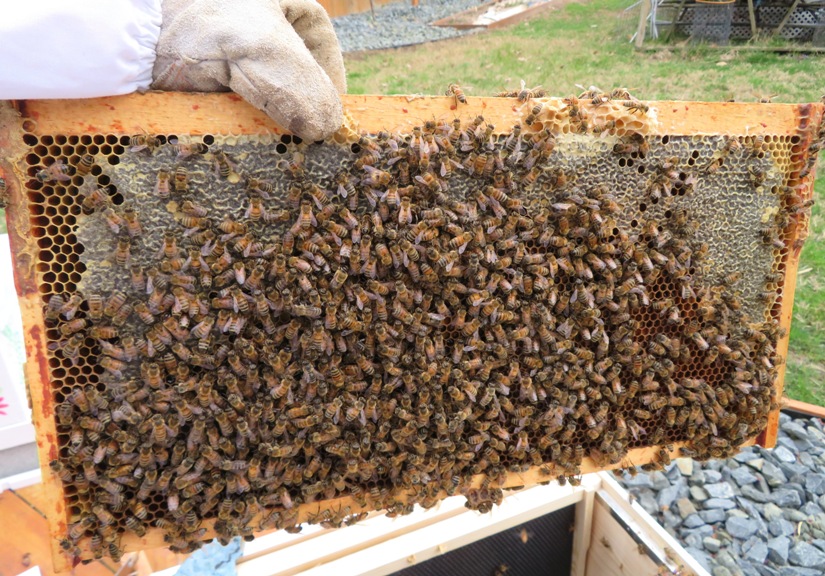
The lower part of this frame in this blog's cover photo contains nectar. After replacing the frames and pollen patty, I opened up the north hive. It was looking much healthier than the south hive. Recall that the nuc came with five frames. I put them in my ten frame deep which means there are five new frames. My new frames have black foundation. The white comb on this black frame indicates that bees are building new comb. 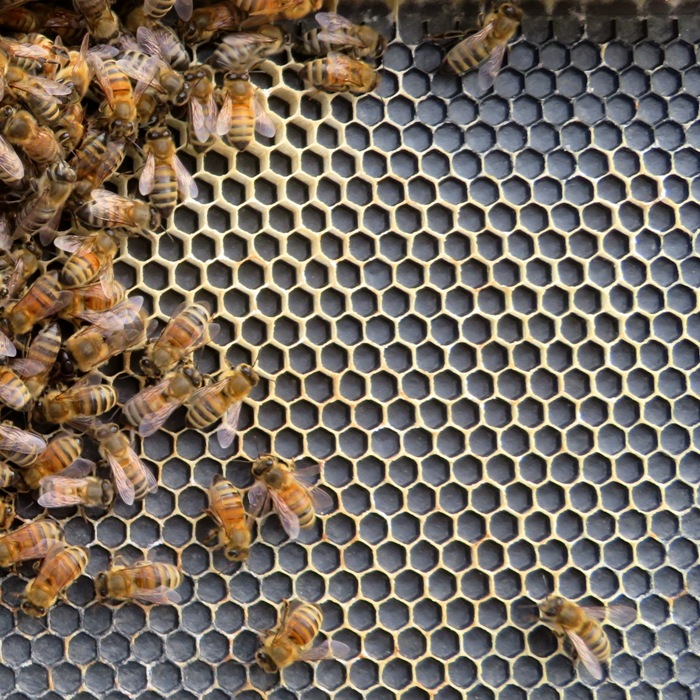
Here's some other photos from the north hive. I did not see any hive beetles or other pests but I also wasn't looking that hard. I did not see the marked queen in the north hive either. I reported things to Brian and he felt that checking the south hive next week would be a good idea. I should expect to find eggs by then.  |

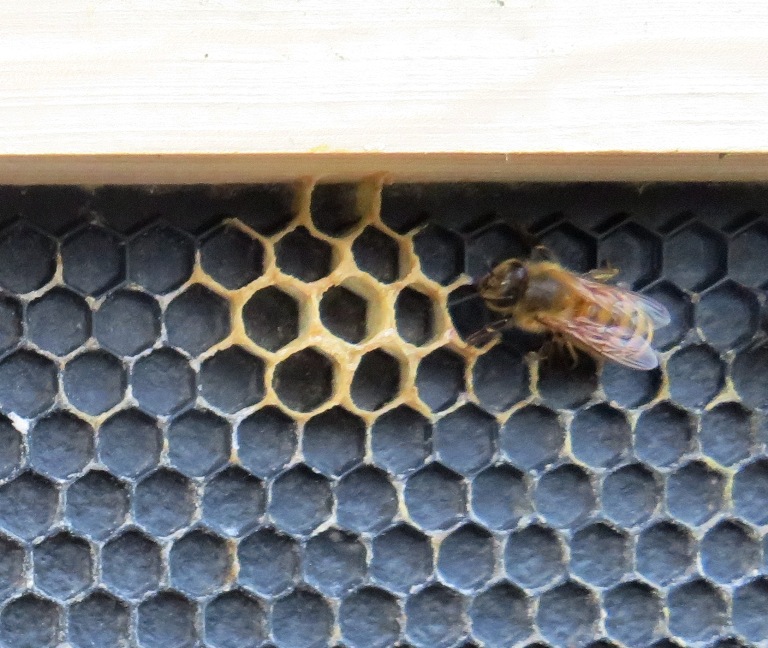
|
I checked the south hive. It was 70 degrees with little wind.
The south colony has quite an appetite. In just five days, they drank about 80% of the sugar water in the quart Mason jar shown below. The north colony drank about half their sugar water. 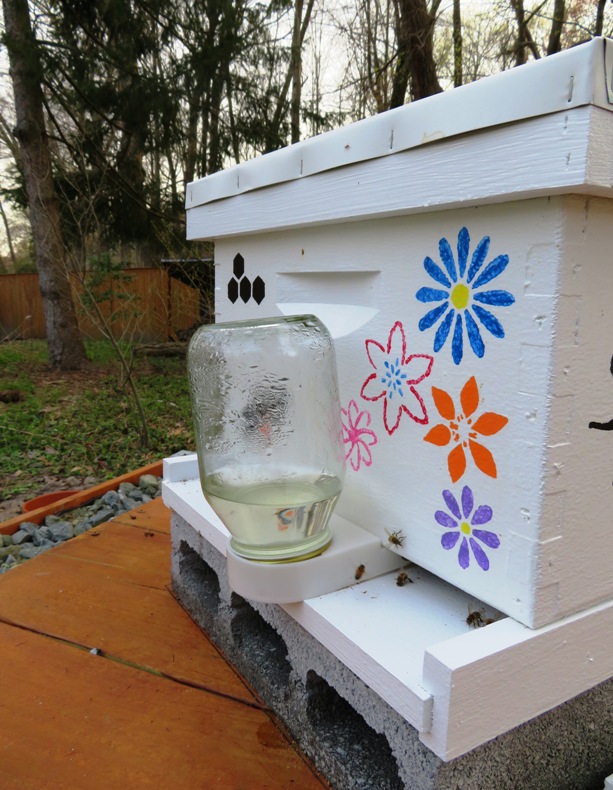
I donned my beekeeper clothes and smoked the hive to subdue the bees. I keep having problems with the fire in the smoker going out but I'm sure I'll get the hang of that with more practice. Next, I opened the hive. Five frames came with the nuc they were delivered in. But the black foundation frame in this blog's cover photo is not from the nuc. The yellow wax indicates that the bees are starting to expand into the new frames. That is a good sign. This is a healthy frame, full of bees. 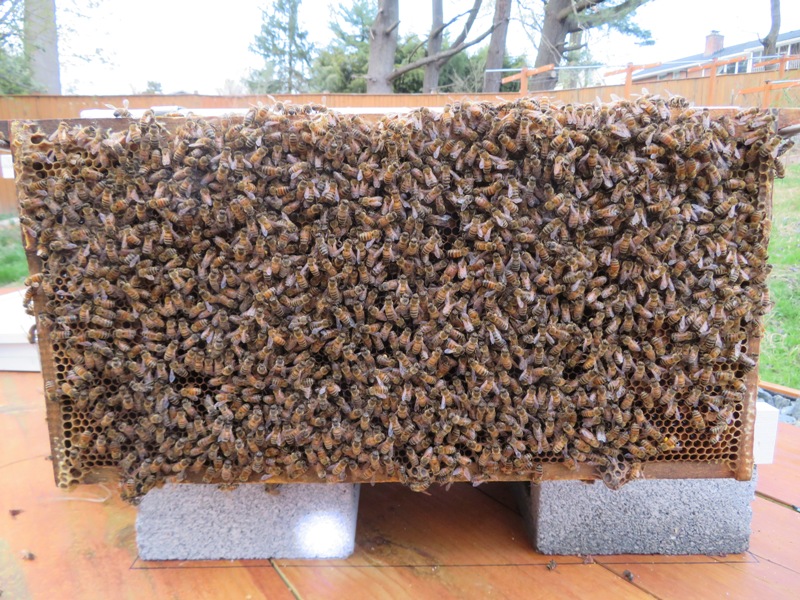
Here's a worker with pollen on her legs. 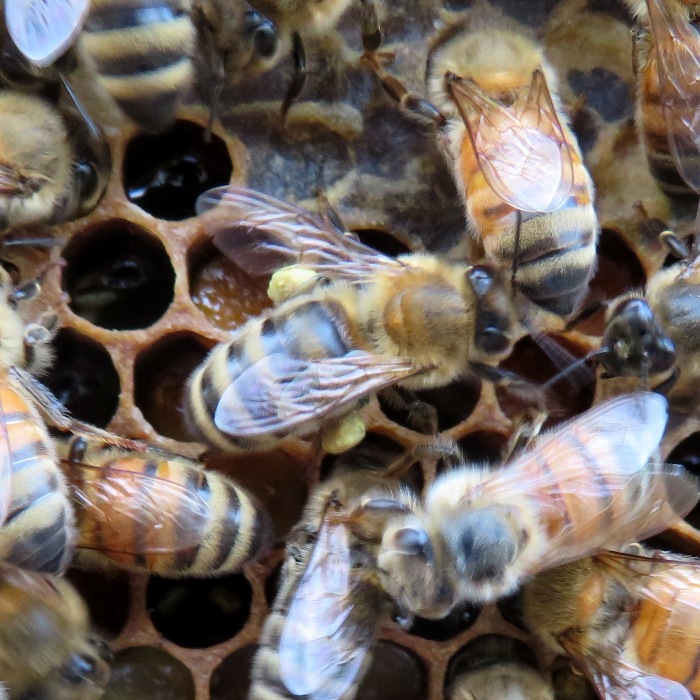
I spent a lot of time looking for eggs. It was late in the day so I didn't have a lot of light. Looking through the mesh veil of the beekeeper outfit also makes it hard to see. But I did have my camera and flashlight. I wasn't totally convinced there were eggs until I downloaded the pictures I took and then zoomed in. The below photo clearly shows the queen is laying. Eggs hatch in three days and since the previous queen was removed on March 27, 2021, I know these eggs are from the new queen. 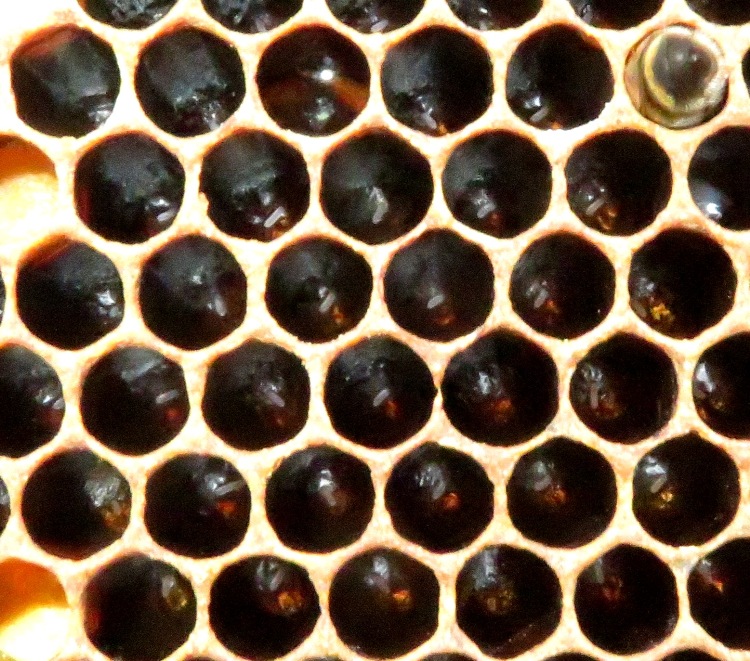
And here is the queen. Notice how long her abdomen is and how short her wings are. Also notice how so many of the workers are facing her, catering to her every need. When I have another pair of hands, I plan to mark her. 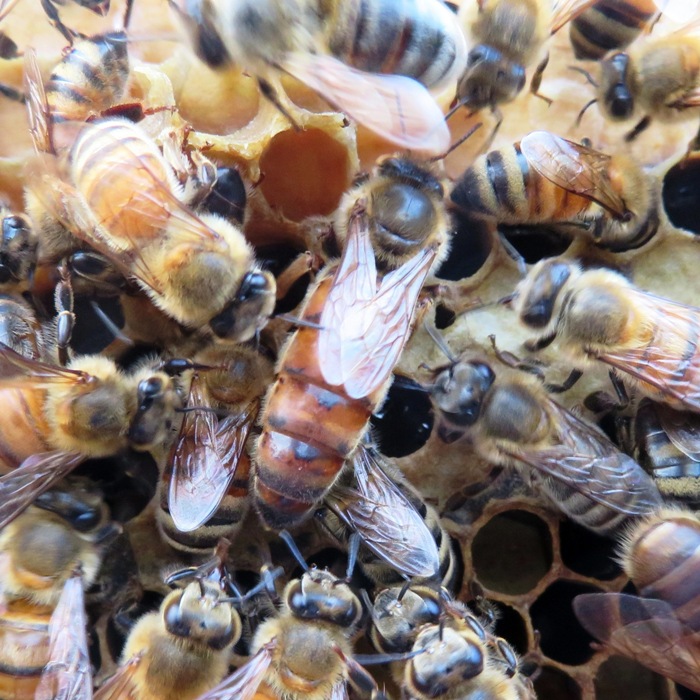
At the bottom of the hive, I saw this thing. At first I thought it was a dead larva or pupa but Eric says it is a greater wax moth chrysalis...not good. It is known to ...eat beeswax, particularly unprocessed wax, pollen, remains of larval honey bees, honey bee cocoon silk and enclosed honey bee faeces found on walls of brood cells. - from BeeAware - Wax Moth 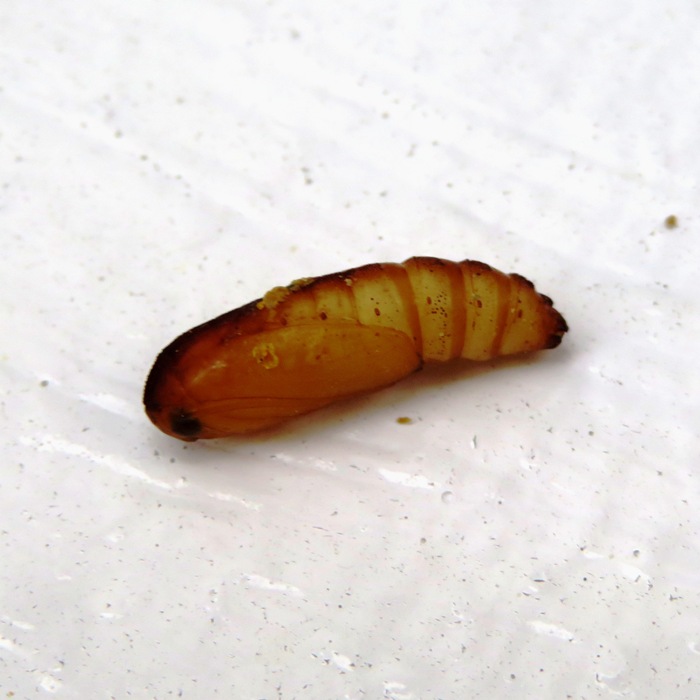
Regarding the greater wax moth, Eric says, Not the end of the world, and since you've already requeened whatever issues that were going on causing poor colony strength should be remedied. I'd just look at your capped brood for empty spaces in the capped brood that look like chevrons or straight lines, as that can indicate you're still having some wax moth larvae in there. If it's a problem after that, increase ventilation (they don't like ventilation).  |
|
I named my queens. The algorithm is that the first letter of the name is the first letter of the breed or the animal. So since they are bees, the first letter is 'B'. There is a south hive and a north hive so I need to make sure the name of the queen for the south hive also has an 'S' in her name while the queen for the north hive has an 'N' in her name. Hence, the names I have chosen for the south and north hives are Betsy and Bernice, respectively. |

|
I set out to inspect my hives. I had some goals. I think it is good to have goals when inspecting the hives because every time you open up the hive, some bees will likely die. But like Eric says, he wants to leave the world with more bees than he started with. So here are my goals for today:
I'm still having problems with my smoker. This time I used firestarter but even that didn't work as good as what I would have liked. I think I'm packing the smoker with too many pine needles and smothering the fire. Norma was there to help me as my photographer. That definitely helped speed things along. I started with the south hive. Some comb was built below the frame. Looking inside some of these cells, I saw dimples from other cells that backed up to them since there was no foundation to separate them. 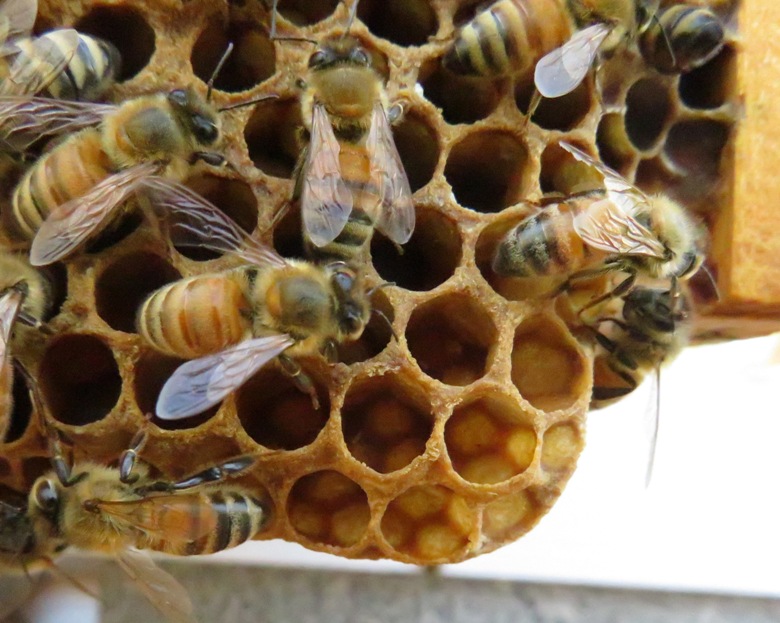
I saw this half-inch long non-bee larva at the bottom of the hive. Other than this, I saw no other pests or signs of pests in the south hive. 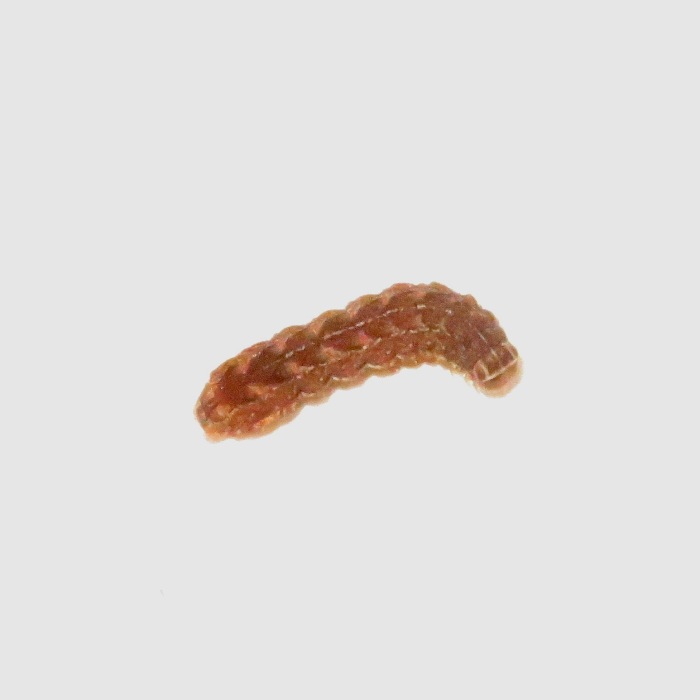
The south hive queen marking did not go well. In fact, it was a f**king disaster. My white paint pen was dry. I thought the other colors I had were too dark so I used some yellow paint from a can of spray paint. I sprayed it into a cup and then used a small paint brush to apply it. What I didn't know was that bee paint is water-based and non-toxic. Instead, I was using mineral spirits-based paint. Not good. I didn't think to check to see if queen bee marking paint was special but now that I think about it, it was stupid of me not to check. I caught Betsy with my new marking tool. I tried to be gentle but maybe I wasn't as gentle as I should have been. Once I caught her (and an inadvertent worker), I noticed that she was lying sideways. One really needs to be gentle with queens. They are not expendable like the workers. Since she was lying sideways, it was difficult for me to mark her. I avoided getting paint on her head and abdomen but I got quite a bit on her wings. I released her back to the hive and then observed her. She was not acting very bee-like. She was still turning sideways. The workers were all tending to her, trying to clean her up. I felt really bad. 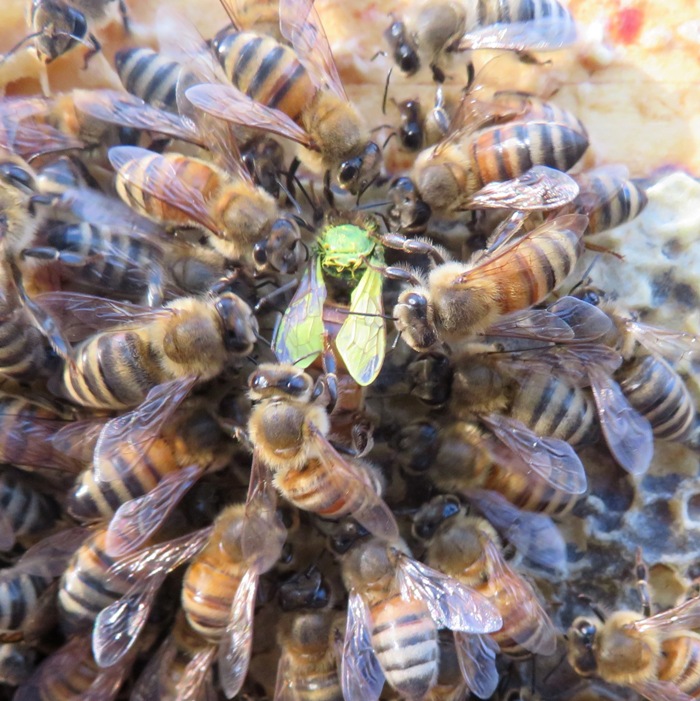
Later, I learned that I should have practiced on a drone first. So here is what I learned about marking a queen. Eric made the whole process look very easy but it was not. Maybe it will be over time. After adding more pollen cake to the south hive, I went to work on the north hive. I sa lots of bee larvae. I found Queen Bernice with her white dot. She appeared to be healthy. 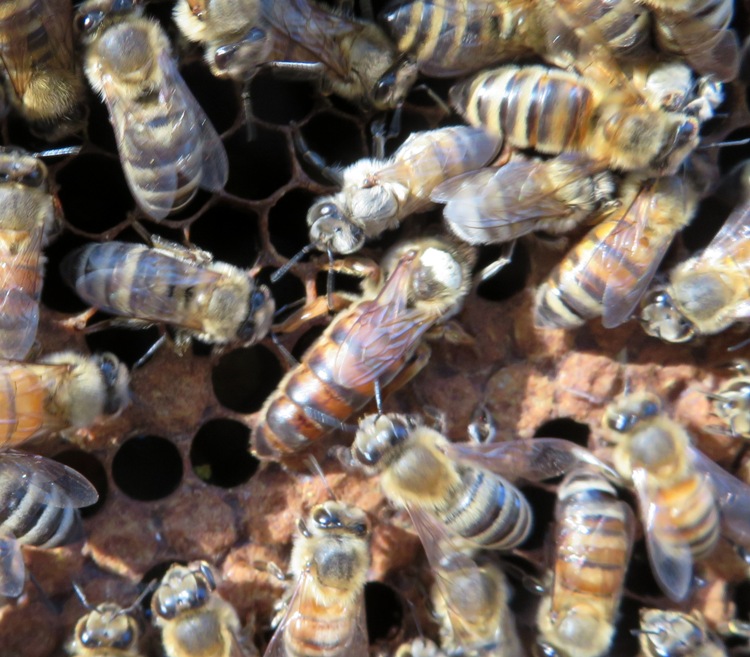
One of the frames had a hole through the top. Not sure what could have caused that. I'm not trying to attract carpenter bees. I later found out that a wax moth did this. 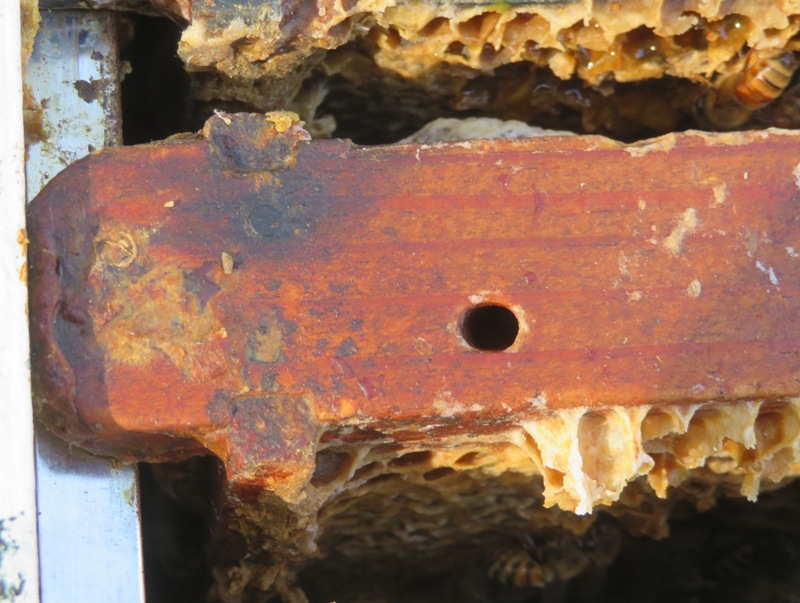
I accomplished my goals, though I did a crappy job with the second one.  |

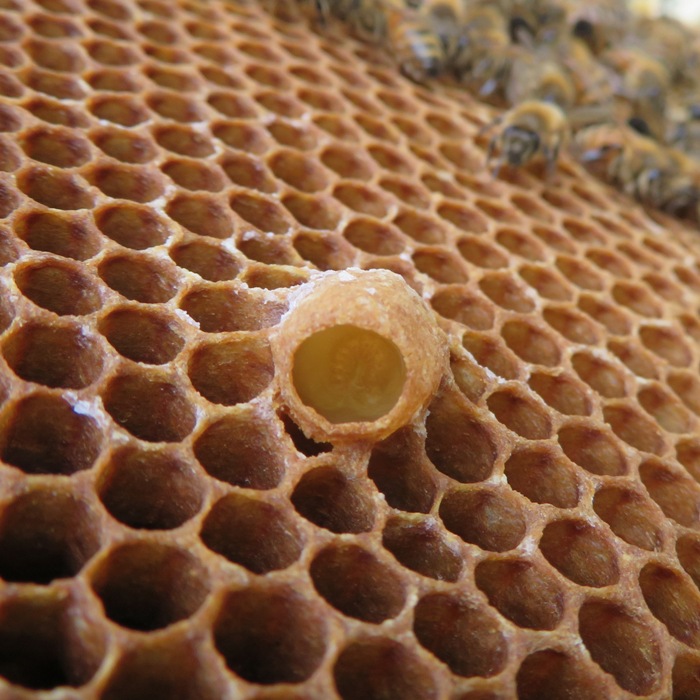
|
Brian, Eric, and I checked the hives. Our mission was
In my south hive, the queen was nowhere to be found. There were also no eggs. This means she died shortly after I marked her on April 13. But all is not lost. The bees are creating supercedure cells, such as the one shown below. These are large cells where the larva are fed a lot of royal jelly to make them queens. Then when a new queen emerges, she kills the other pending queens, mates with a drone, and then takes over as the new queen. 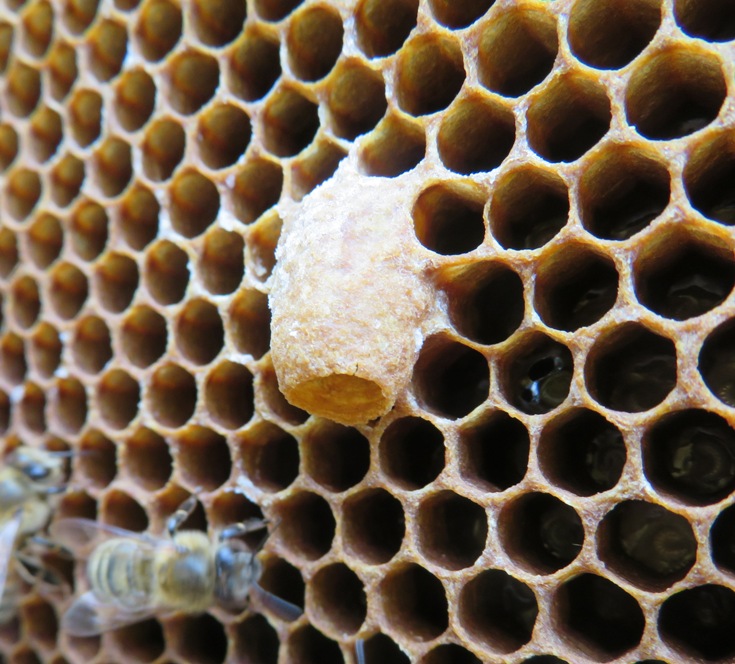
Looking into the supercedure cell (shown enlarged in this blog's cover photo), you can see the larva. I will check the hive again in a few days. If this cell is capped, then it has become a pupa, which is good. If something has eaten through the cell and killed it, then that means a new queen has taken over. That too is good. We took a frame with eggs from the north hive and put it in the south hive so the workers have more opportunity to create a queen. I call that reallocating resources. In the north hive, I found a swarm cup, shown below. It is an empty supercedure cell built below the frame. When there are too many bees for the hive, they try to produce a new queen who can then take half the colony away in a swarm to find a new home. This is an indication that it is time for me to add another box of empty frames to the hive...sort of like getting an addition to your house after you have a lot of kids. 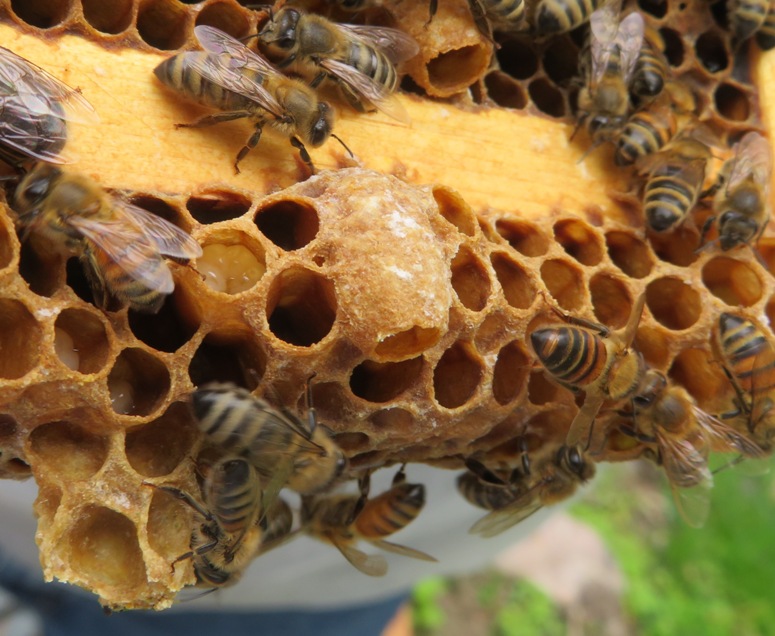
On Thursday (or once night temperatures warm up), I should add a deep to the north hive. Doing it too soon isn't good because it will be harder for the bees to stay warm. Doing it too late means they might swarm if they feel cramped. Below, a new bee emerges from its cell for the first time! It has just undergone metamorphosis from pupa to adult. Here it is chewing through its wax cap. 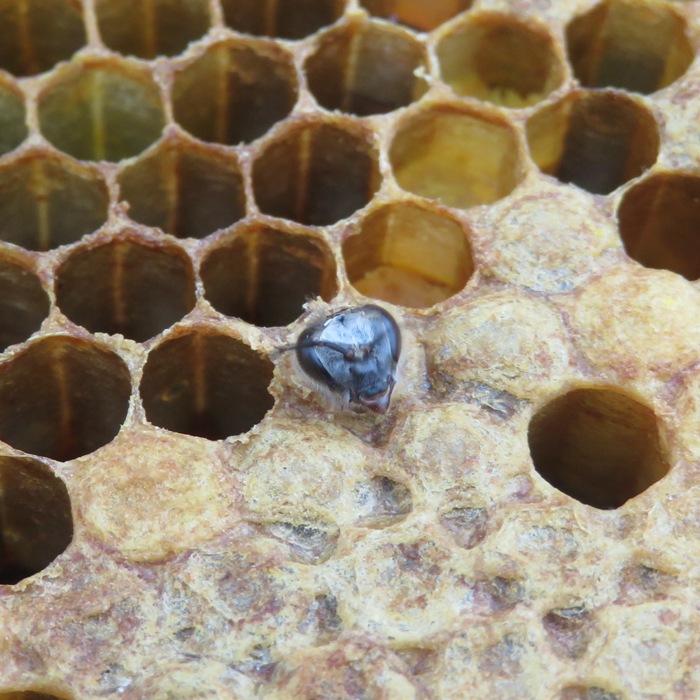
In the upper half of the below snapshot are drone capped brood. In the lower half are worker capped brood. Drones are bigger than workers so their larva and pupa need bigger cells. 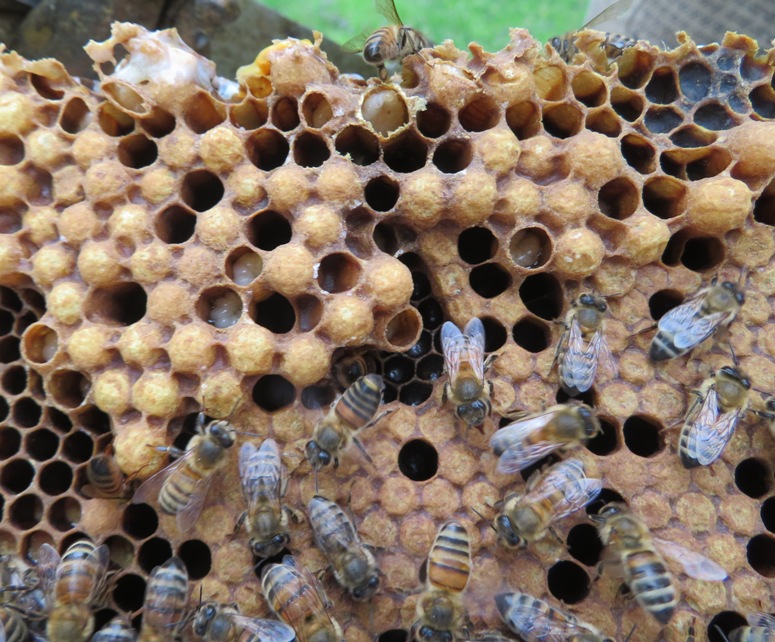
Drones can't sting. They help with temperature regulation of the hive and are good for neighboring beekeepers that have a queen looking to mate. They are also good for new beekeepers like me to practice marking a queen before actually doing so. After separating two frames, some of the bees grab onto each other and form a chain to fill the void. Every time I see this picture, I think of the song "Chain of Fools." 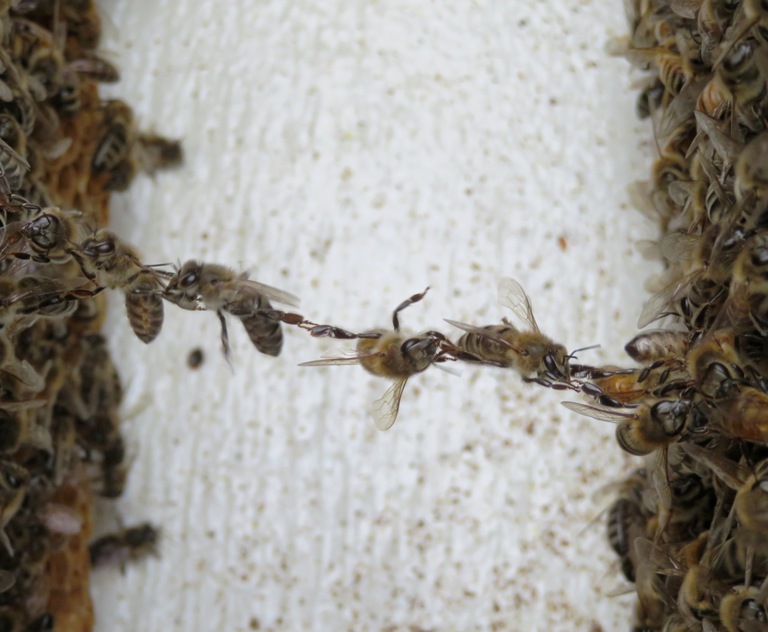
Eric performed an (isopropyl) alcohol wash to count mites in the north hive. To do this, he removed a sample of bees from a frame, put them in a jar, and then shook them in a solution of alcohol. This kills them but allows him to count the mites. He found none. The main thing when doing this is to identify which frame has the queen and do NOT use it for the mite count procedure. He says the alcohol wash method is more accurate than the sugar shake method, though the latter doesn't kill bees. 
We saw another small caterpillar-like thing inside the hive. It was the same as what I saw during my last hive check. Eric and Brian didn't know what it was. Brian and Eric said that my bees are very docile.  |

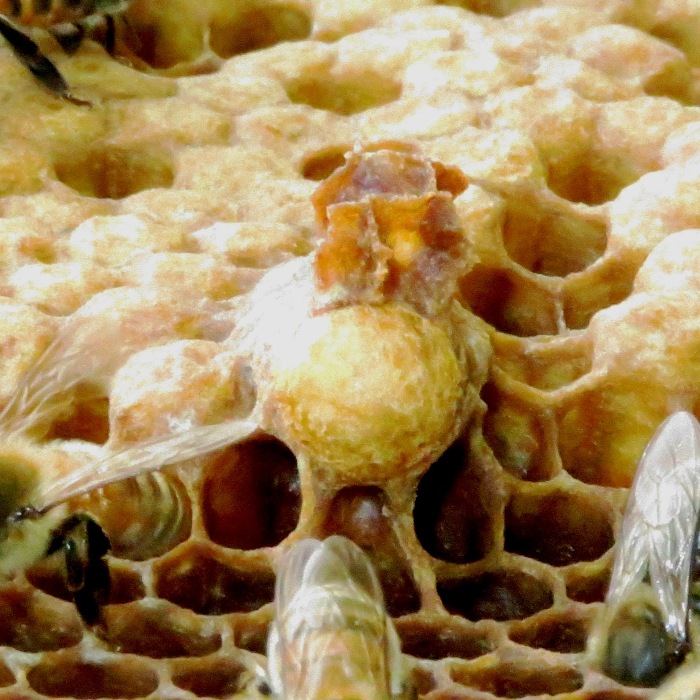
|
My mission was to
After getting the area smoked, I removed the burr comb from the north hive and added another deep. I didn't think they would like me cutting off burr comb but they didn't get upset. I know I would not be happy if someone were to start cutting into my house. 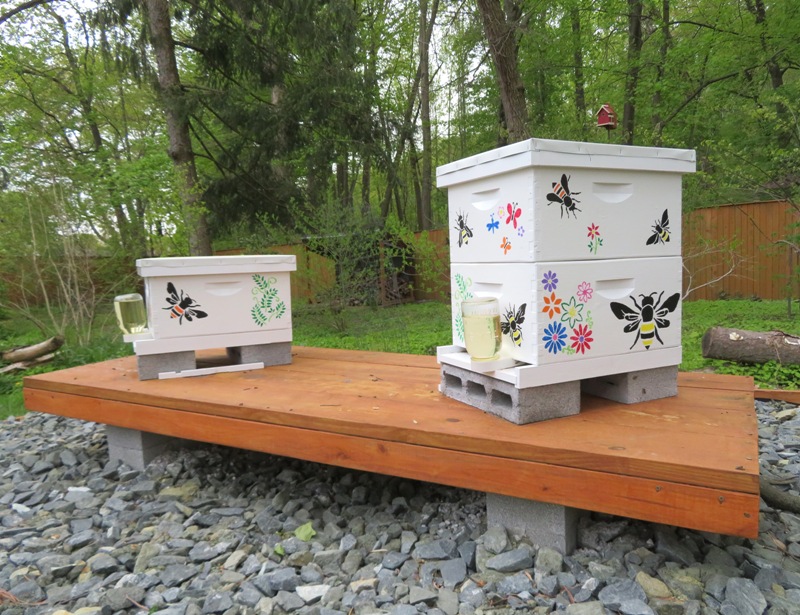
I waited until today to add the deep because the previous nights were cold. Heat generated by the bees would dissipate over a larger space if there were two deeps instead of one. That means they would have a harder time maintaining a sufficient hive temperature if I added the second deep too soon. I thought the north hive looked very healthy. For the south hive, I confirmed that the queen cell (which Eric indicated on April 17 by marking the frame) is now capped. That is good. It means a pending queen is in or nearing the pupa stage. 
I also found another queen cell that has a larva. This one is on the bottom of a frame. Normally that would mean it is a swarm cell but since there is no queen and there aren't a lot of bees (as compared to the north hive), Eric says it is safe to leave it. Eric said that a new queen should be laying in about three and a half weeks and I should check for eggs then. In the meantime, he recommends swapping out a frame of empty space from somewhere not immediately next to the queen cells in the south hive with capped brood and eggs from the north hive. This will help ensure I don't get a laying worker. According to Wikipedia: A laying worker bee is a worker bee that lays unfertilized eggs, usually in the absence of a queen bee. Only drones develop from the eggs of laying worker bees (with some exceptions). A beehive cannot survive with only a laying worker bee [and no queen]. I should do this frame swap next week and then weekly. Eric says It is not uncommon to have one strong hive and one weaker hive, and for this reason it is good to have at least two colonies to support one another for these types of queen events. I found this weird-looking cell that opens outward. Something tells me good project management was lacking. 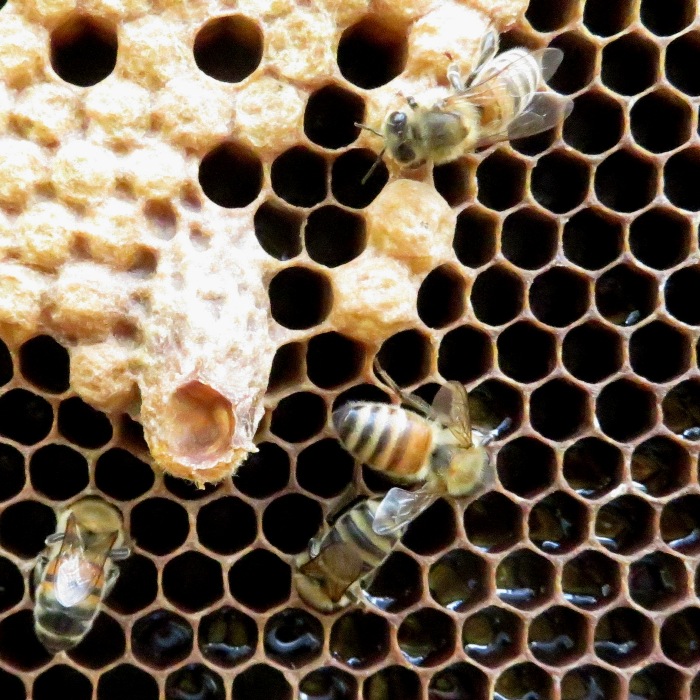
I also found this emergency supercedure cell which looked empty. 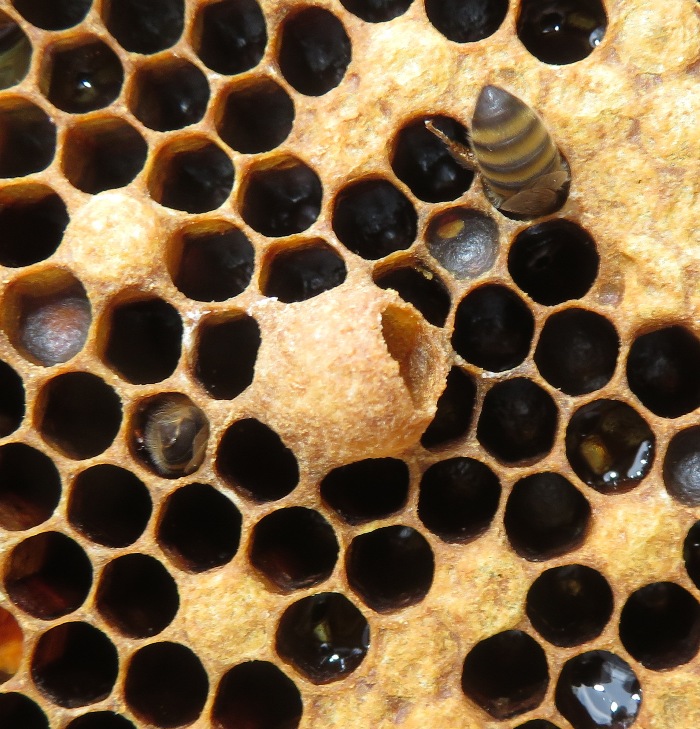
Here's another view. 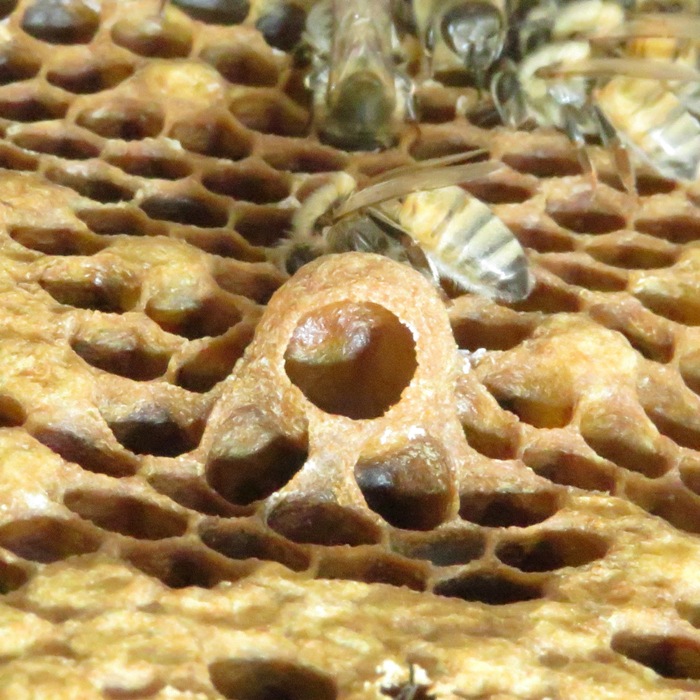
I don't like having problems with the hive but maybe it is good because it forces me to learn a lot. It is certainly better to have this drama when I have such good mentors like Eric and Brian than to go it alone.  |

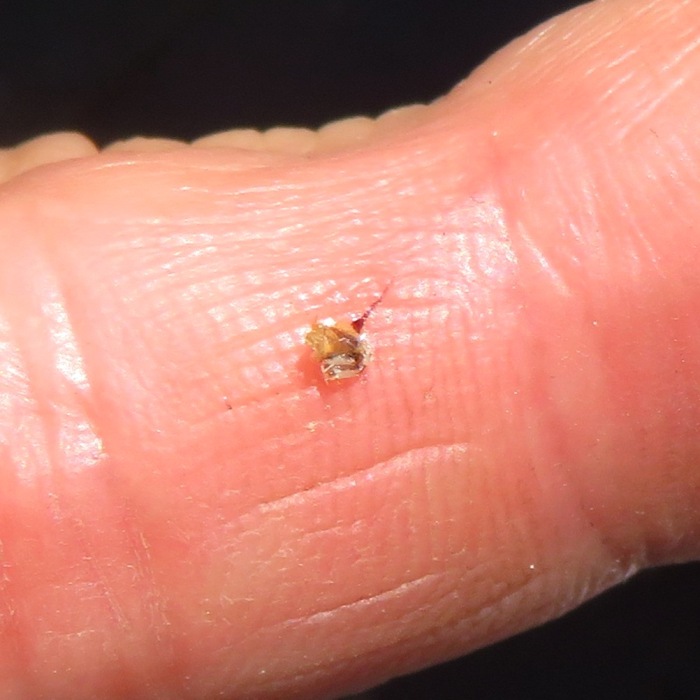
|
My mission that day was to
If I did not find eggs in the south hive, then I also wanted to The photo below shows one of the capped queen cells in the south hive that I found on April 23, 2021. But it is now open. So either it hatched or another queen hatched prior to it and then killed this queen. I could not find the other queen cell which I saw on the 23rd. I was also not able to find any eggs. So if the queen is there, it might not have mated with a drone and begun laying. I also did not find larva. 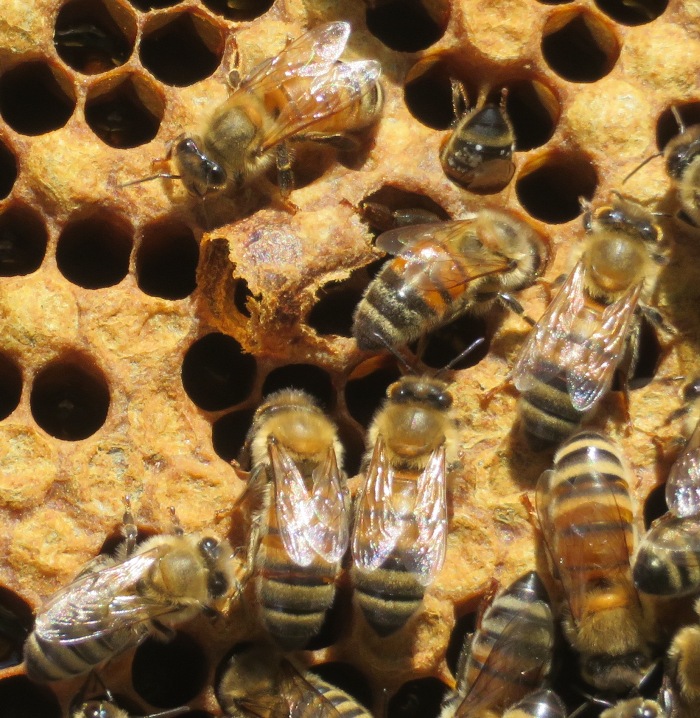
One thing I learned is how to visually differentiate between bee pollen and bee bread. According to Bee pollen versus bee bread - nutritional value and biological properties: Bee pollen is a mixture of flower pollen, nectar, enzymes, honey and bee secretions. Bee Bread is a fermented mixture of plant pollen, honey and bee saliva that worker bees use as source of protein for larvae, and for young bees. Eric said When workers bring pollen in, they store it for future use, dry. You can tell the bee bread from the pollen by the "wet" appearance. Bee bread appears to be a little shiny. I found that the bee bread in the south hive looks shiny and yellow. I think of putting butter on bread. As the butter melts, it looks shiny. So that's how I remember it. In the north hive, I found and killed a small hive beetle. According to Bee Health - Managing Small Hive Beetles The small hive beetle Aethina tumida (SHB) is an invasive pest of bee hives, originally from sub-Saharan Africa. These beetles inhabit almost all honey bee colonies in their native range, but they do little damage there and are rarely considered a serious hive pest. 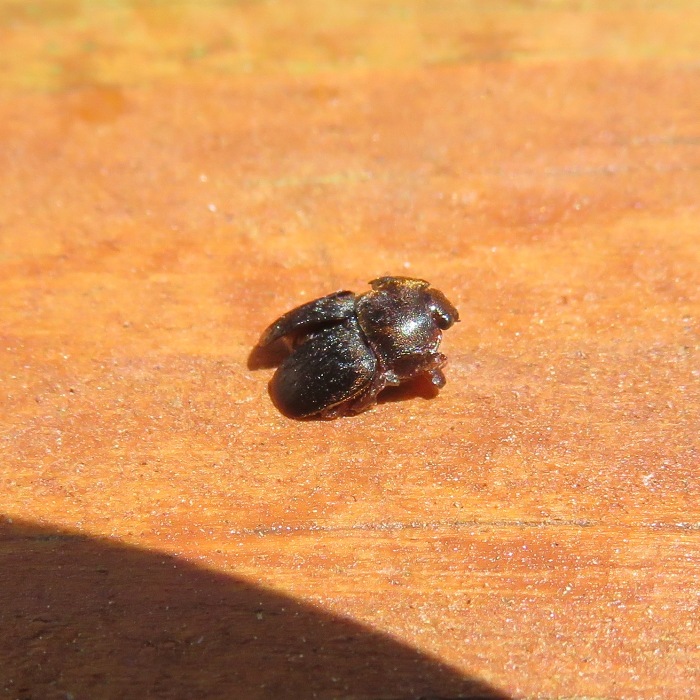
I never found the queen in the north hive. I'm pretty sure she was there. Everything looked healthy. But since I could not locate her, I was hesitant transferring a brood frame from the north hive to the south hive. After I removed my gloves and beekeeper suit, I noticed a bee on it. I tried to shake it off and somehow managed to get stung. It didn't hurt much...probably because my hands are a little callused. Sort of a throbbing pain that went away once I removed the stinger, which is shown in this blog's cover photo. I explained my dilemma to Eric regarding my hesitancy to swap frames. He replied, I would recommend shaking the bees off of the north hive frames and place the brood frame in the south colony until the south hive queen is mated and starts laying. Any bees that are still clinging to the frame are likely young nurse bees and are safe to go. The next day, I did just what Eric said. I wasn't so sure about shaking bees off a frame but I did it and they didn't get too upset. I then marked the transferred frame. 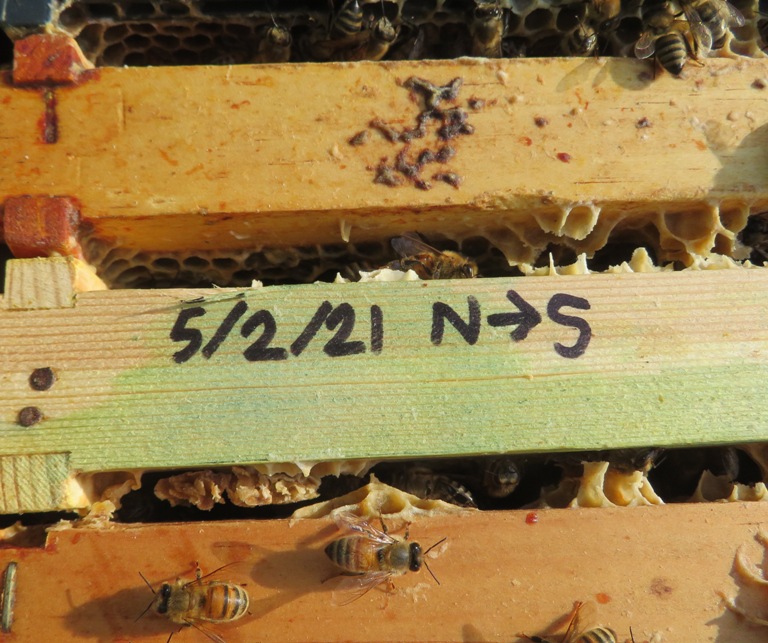
I'll wait at least four days and then check the south hive. If I find eggs, then I know they are from a newly mated queen.  |

|
On this day, my mission was to
I found no eggs in the south hive, which indicates that there still might not be a queen present. I also did not see any queen cells so they might not even be trying to make a queen. Then I opened up the north hive. I found the queen and noted which frame she was in. She is marked with a white dot, which is starting to fade. Then I took two other frames from the north hive with eggs and larvae and transferred them to the south hive to help strengthen the colony. 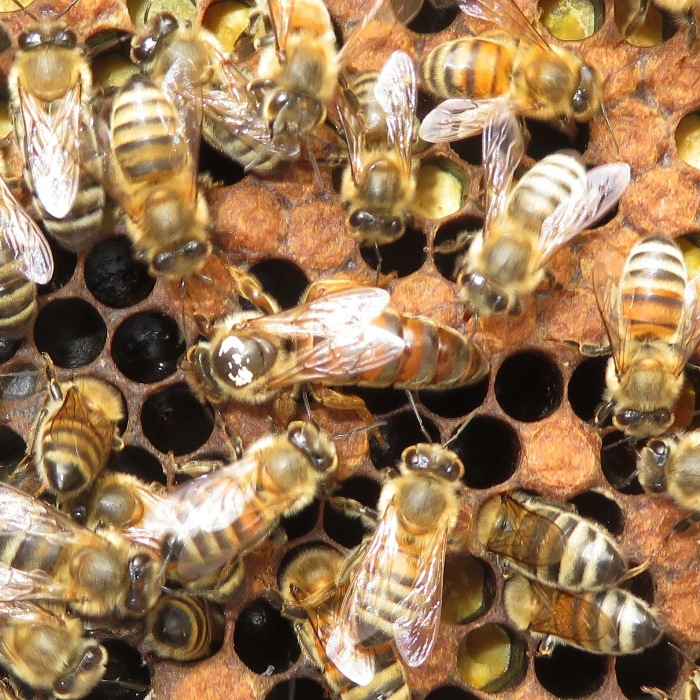
While in the north hive, I saw some unusual dimples between cells. What could they be? Eric M. said, My best guess would be, judging by the size variations of the cells (smaller cells noted at top) is that when they were drawing the cells, they ended up having a small area open. I'm not sure why there would be a dimple versus just flattened comb. I attributed the dimples to bad project management. 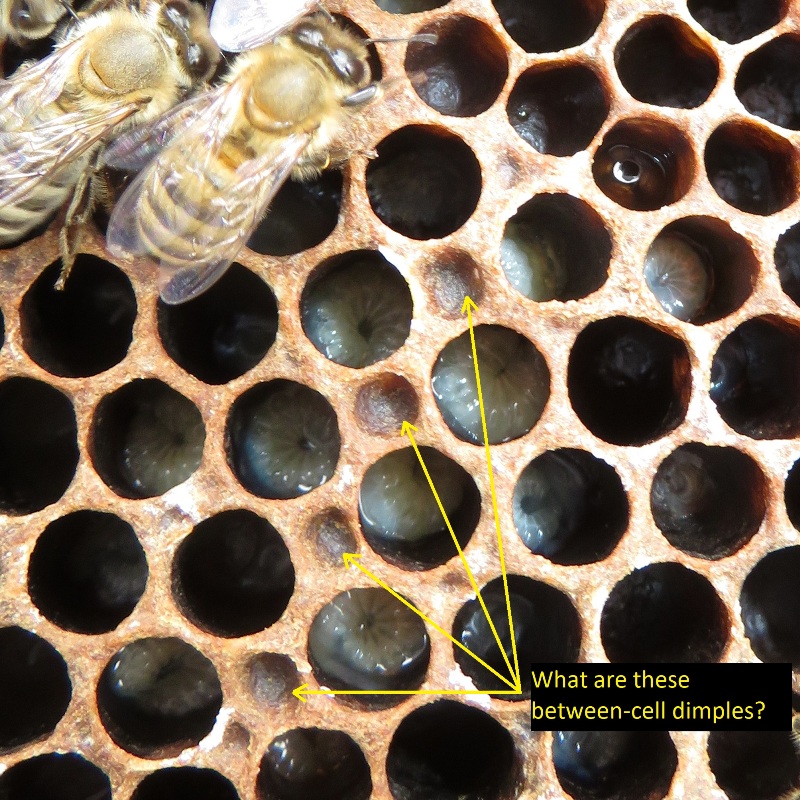
I found plenty of eggs in the north hive that were quite visible against the black foundation. 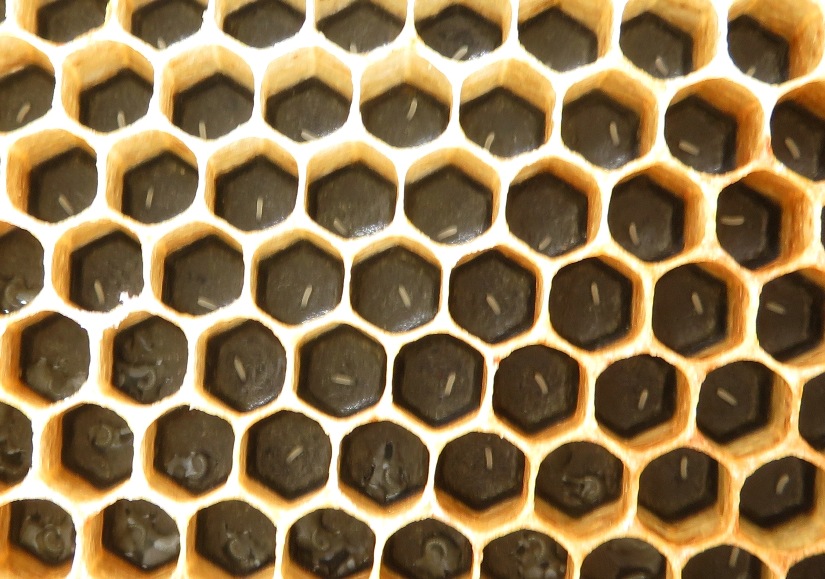
 |

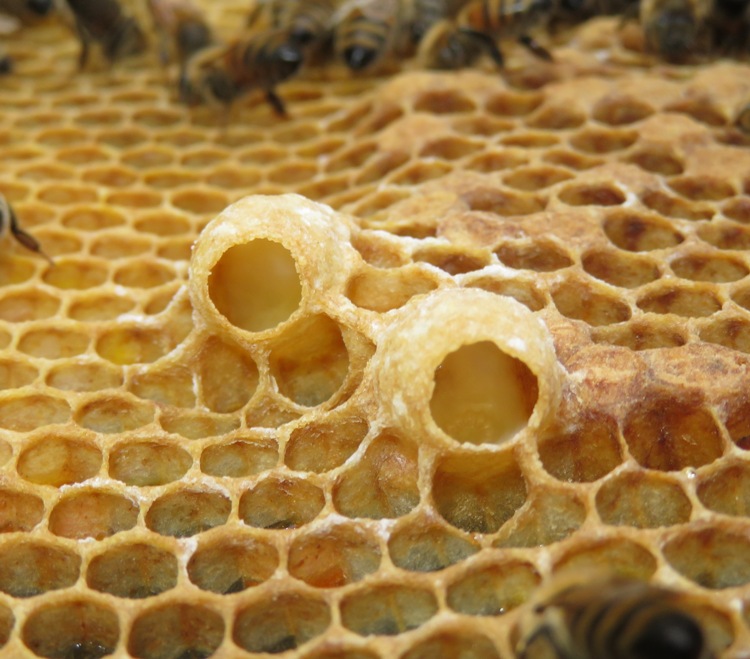
|
My mission was to
I was concerned because the south hive had been queenless since about April 14, 2021, despite my efforts to get them to create a new queen. So on May 14, after consulting with Eric M., I went to HoneySmith Bees LLC in Odenton, Maryland, and bought a mated and marked Italian queen bee. 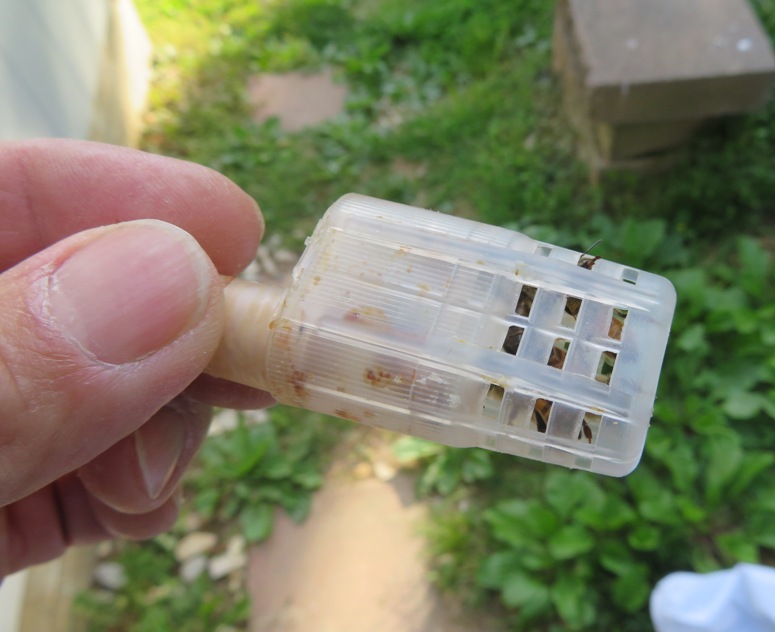
I then introduced her to the south hive. Upon doing so, I found that maybe I purchased too soon. The colony was clearly making strong efforts to fill the void. 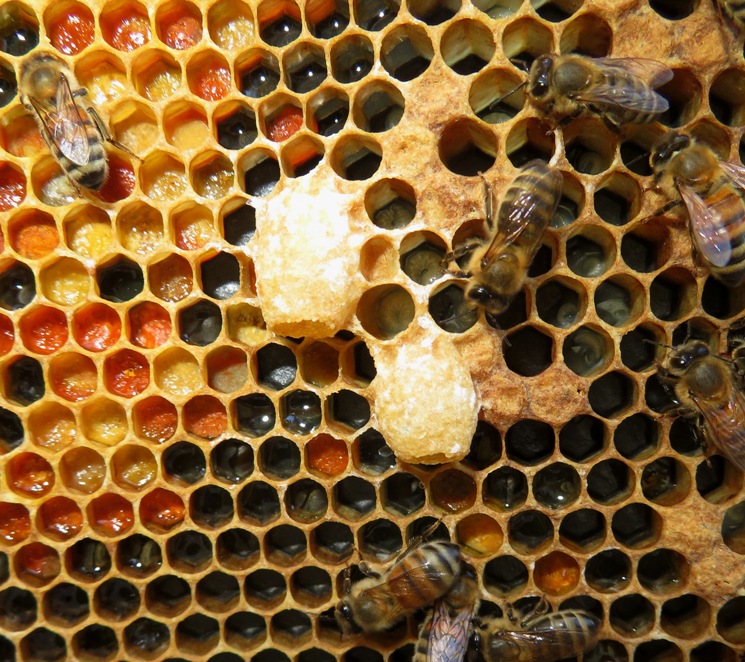
This blog's cover photo, shows the same cells but from a different angle. If you look really, really hard, you can see a small larva in the cell on the right. Queen cells in the south hive: I decided to go ahead and introduce the Odenton queen anyway, figuring it would just increase my odds of success. Whoever emerges and is accepted by the workers first will kill the other pending queens and reign supreme. Why an Italian queen? Italian honey bees have many positive traits. They are I pushed the cage containing the Odenton queen onto a frame so it would stick. In a few days, the workers should eat through the candy plug and set her free. By then, they would have gotten used to her scent and accepted her as one of their own. 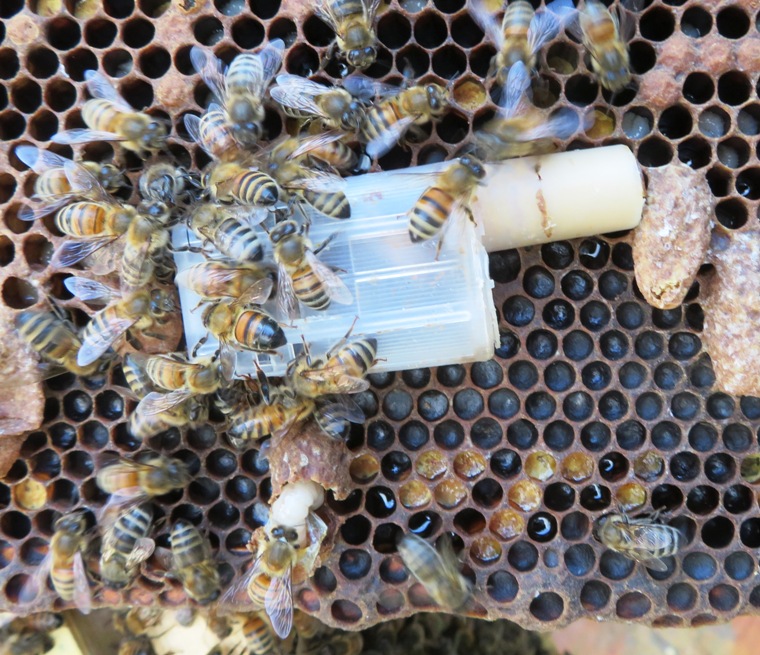
If I don't get a laying queen after all this, I might just as well throw in the towel.  |

|
My mission was to
I checked the south hive. Recall that three days prior, I introduced a new queen. She was in a small cage that I inserted in the colony that would hopefully become her new home. The opening to this cage was blocked by some candy that would take a few days for the workers in the hive to eat through. That would give them enough time to get used to her scent and accept her as their queen. I opened the hive to ensure the candy had indeed been eaten and the queen freed. That was the case. 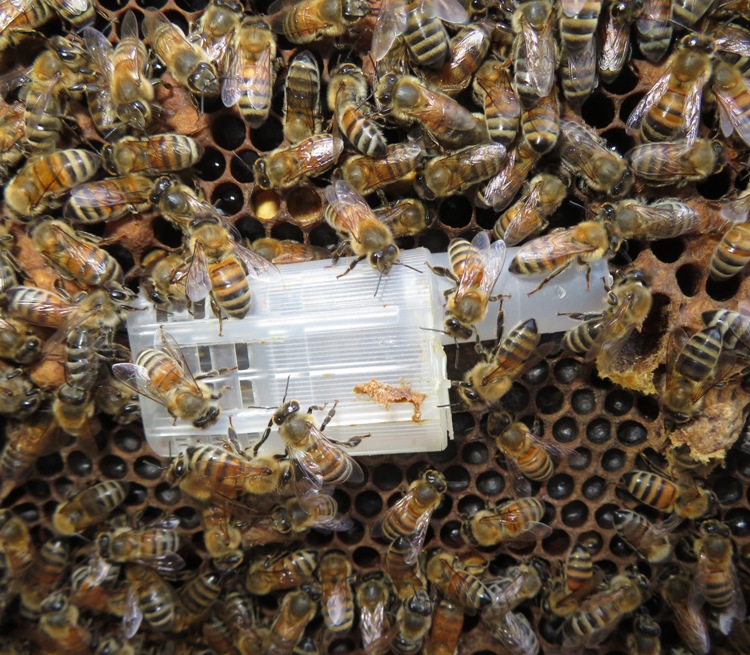
The next question was whether or not she emerged prior to another queen being born. But I really wasn't too concerned about which queen ruled the colony, as long as I had a laying queen. By the way, whoever the south hive queen is, I will refer to her at Betsy. I checked for eggs. None. But that doesn't mean I don't have a laying queen. She might have just been freed. So I'll give it a few more days and then check again. The south hive was so full of nectar, honey, pollen, and bee bread that I added another deep hive box to give them room to expand. In this picture, I am gesturing the number of hives I have. 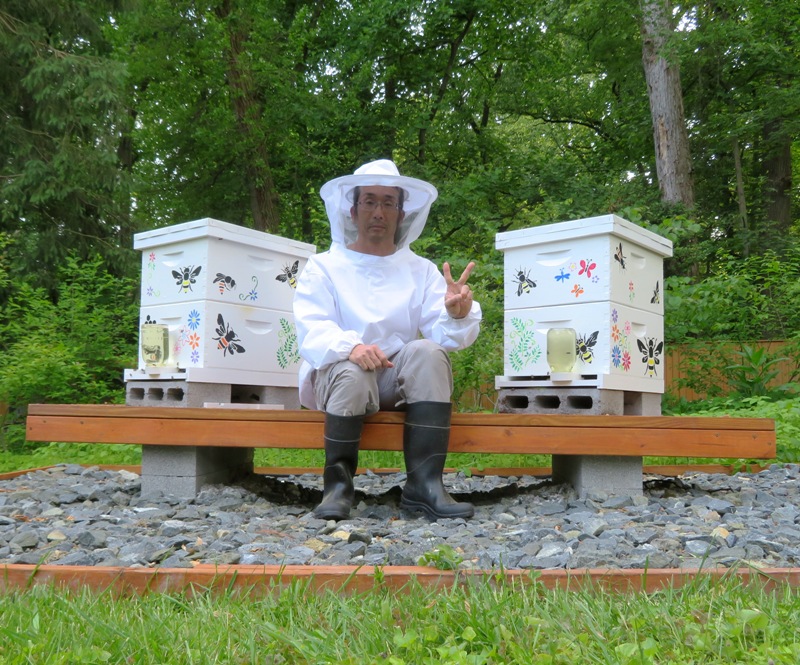
Recall that my bees are all Italian. Why not American? Honey bees are not native to North America. They were originally imported from Europe in the 17th century. - from USGS - Are honey bees native to North America? So not everything non-native in nature is bad. But "invasive" has negative connotations.  |

|
I had only one mission...to
Recall that the queen I purchased on Odenton successfully made it out of her cage when I checked on May 17, 2021. Unfortunately, I did not find any eggs. But this time I definitely did. I was thrilled when I angled the frame to be illuminated by the bright morning sun and saw dozens of them. 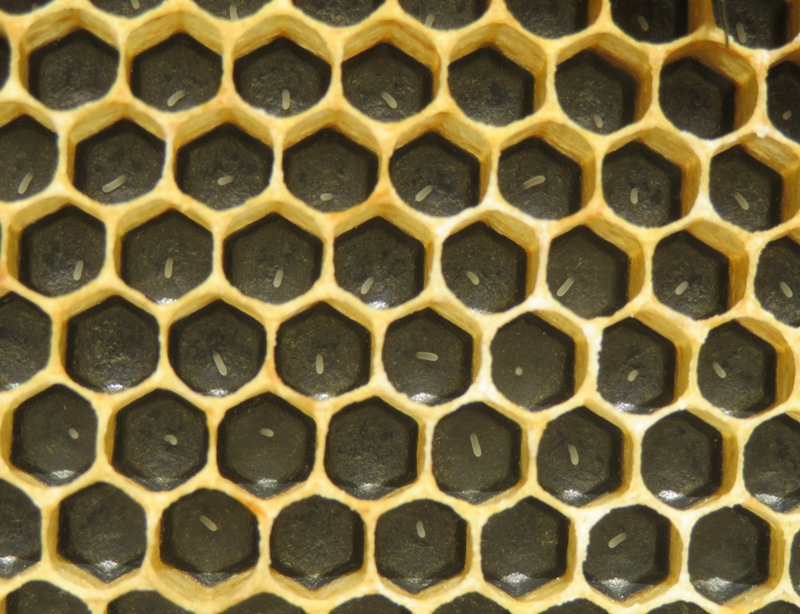
So the south hive now has a new Betsy...a laying queen that will keep the colony strong. I did not see her so I don't know if it is the one I purchased or one that the workers created. Either way, I am pleased with the results. I also checked the north hive. As I pulled the upper deep box away from the lower one at the north hive, some comb between them broke open and exposed some honey. I saved some for Norma, Daphne, and me to taste. We gave it our approval. 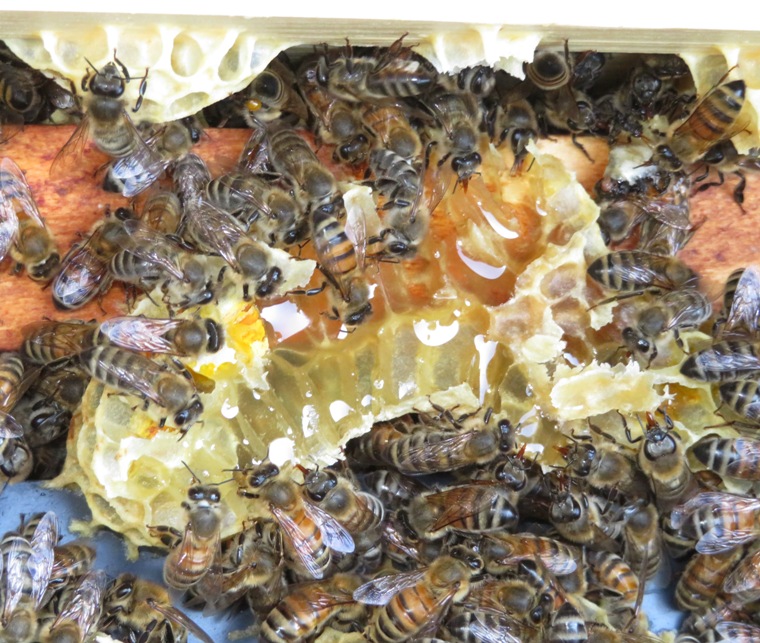
Here are some larva from the north hive. Bernice is hard at work being a full time mother to thousands of offspring. 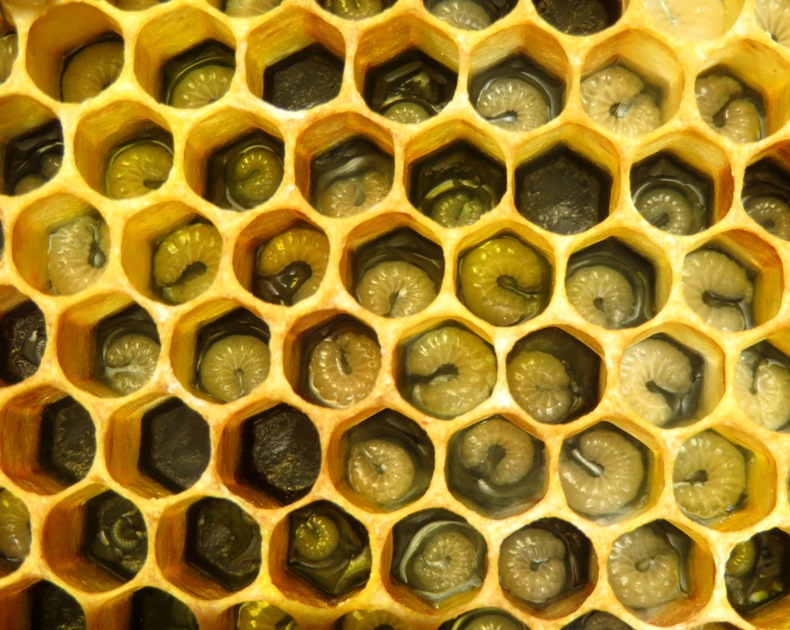
Both hives are healthy and strong.  |

|
My mission was to
I was looking for the queen in the south hive but didn't find her. I thought I would see the white mark placed on her by the beekeeper I purchased her from in Odenton. Maybe it wore off or maybe one of the queens from the queen cells emerged before her and killed her. Either way, there were plenty of eggs and larvae so I'm happy. The north hive had eggs too but it is definitely not as strong as the south hive. Recall that when the south hive was queenless, I transferred frames from the stronger north hive to help them. I figured now it is time for the south hive to pay them back. So I took two frames with eggs and larvae from the south hive, shook them off to remove bees, and then moved them to the north hive. Hopefully, things will be better balanced now. I saw what looked like a carpenter bee or a bumble bee get near a frame that I removed. My girls chased it away. Bees collect pollen from a variety of sources that yield different colors. A really good beekeeper will be able to identify (or at least narrow down) what plant produced what pollen based on the color, region, and time of year. 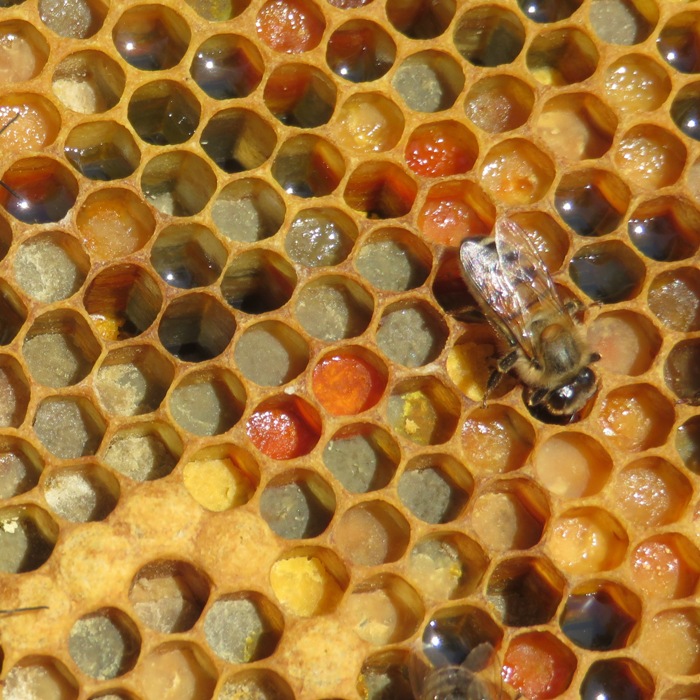
I noticed some of the drones. A drone is a male honey bee. Unlike the worker bee, drones do not have stingers. They gather neither nectar nor pollen and are unable to feed without assistance from worker bees. A drone's only role is to mate with an unfertilized queen. - from Wikipedia - Drone (bee) Drones have huge eyes that touch at the top of the head. Female worker bees have much smaller eyes that are well separated on the sides of their heads. The male's eyes are so much larger because they need to find a potential queen in flight. - from Ask a Biologist - Is It a Boy or Girl Bee? 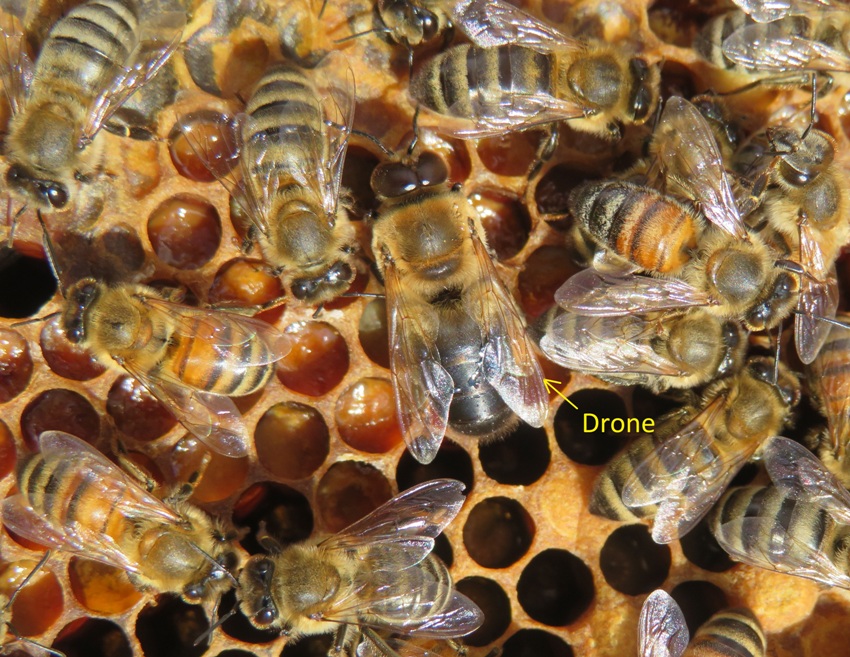
Capped drone cells are larger in diameter and are domed much higher than worker cells. Drone cells are usually in groups at the lower edge of the frame and have a round "bullet shape" appearance. In contrast, capped worker cells are typically found in the center of the frame and are slightly domed, almost flat. - from Bee Maniacs - Cells, cells and cells 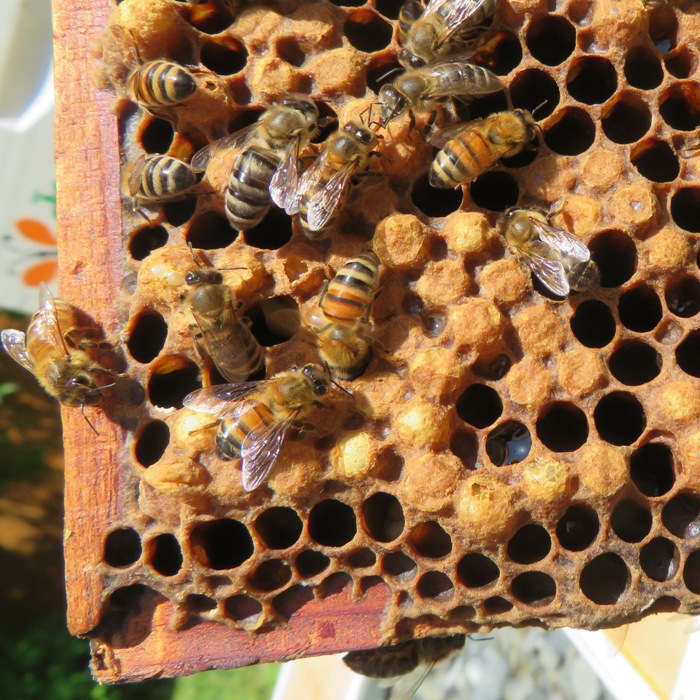
I managed to get stung on my right thigh, just above the knee. This bee probably went up my pant leg. Twenty-four hours later, it was itchy, swollen, and red. It is like a bad case of poison ivy. I've never felt anything itch so bad. These are signs of a moderate allergic reaction. Nothing to go to the hospital for. Such reactions tend to resolve over five to ten days. 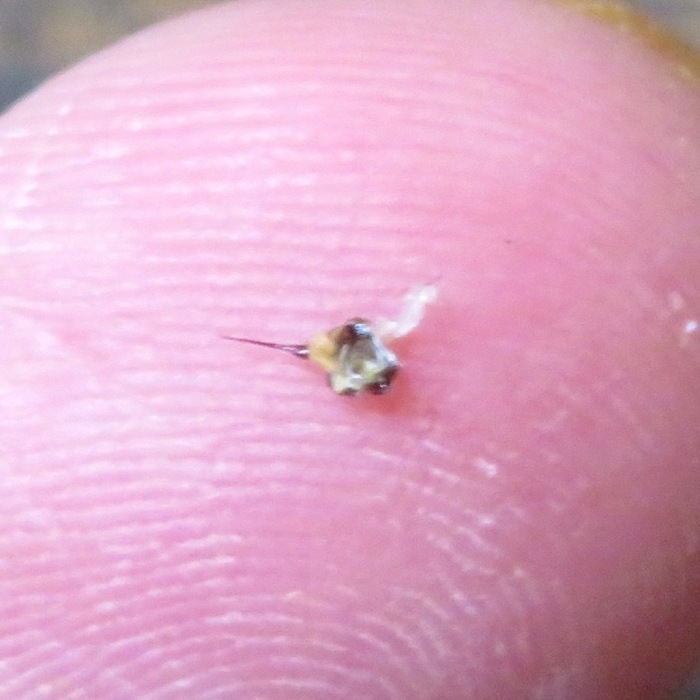
 |

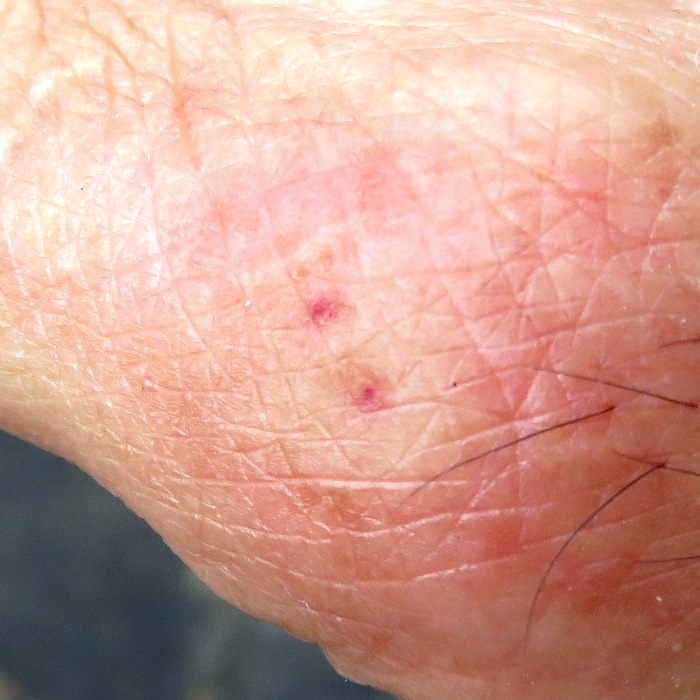
|
My mission today was to
Recall that on June 5, 2021, I moved two frames with eggs, larva, and capped brood to the north hive to help balance things out. I think that is working. I did not see either queen but I saw eggs so I know they are there...or at least they were four days ago. Below, nurse bees take care of larvae. 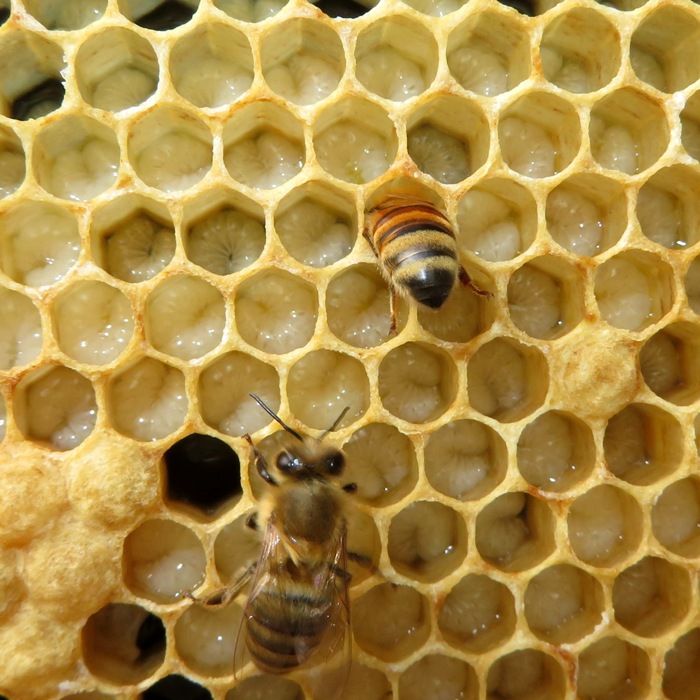
Here's something I've never seen or heard of before. It is a double queen cell, separated by dimples. I did not find anything inside. 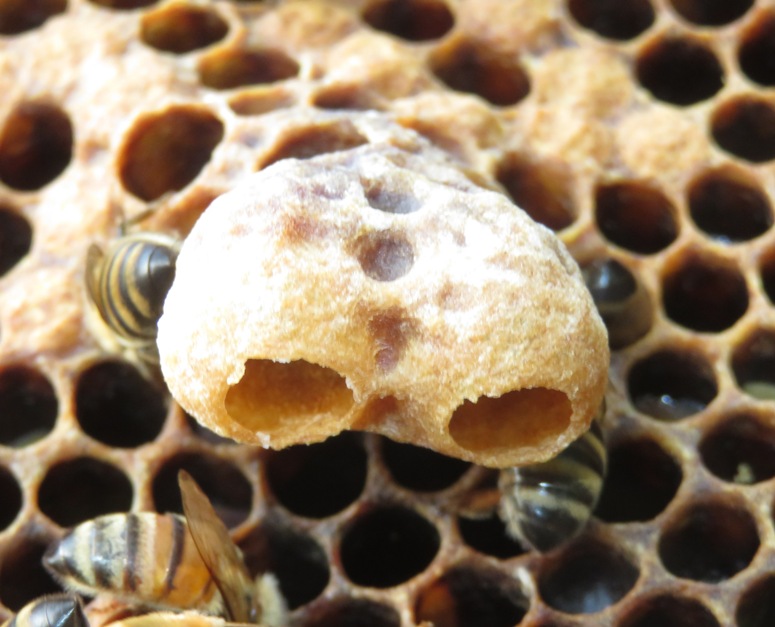
When I pulled out this frame, some of the cell caps came off, exposing a lot of honey. Frames with honey are very heavy. That is one reason why I like the big wooden table/platform that my hives rest on. I can stand on them, which makes it much easier for lifting heavy things. 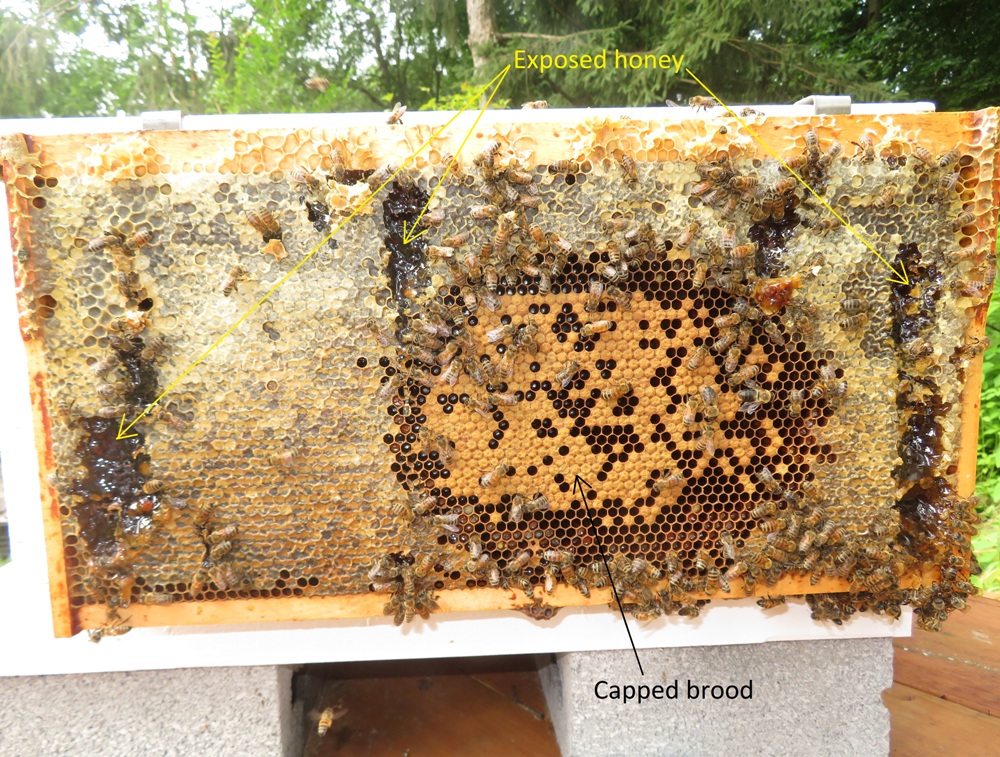
I got stung twice by the same bee. The stinger passed through my thick, cowhide glove. Then I moved my hand and the stinger moved with the glove about a third of an inch and nailed me again. Shown in this blog's cover photo, it sort of looks like a snakebite. A day later, my hand was very swollen. I took topical hydrocortisone and oral diphenhydramine (Benadryl) to reduce the itching and swelling. I only ended up checking the lower boxes of the hives. But what I saw looked good.  |

|
July 31, 2021 was a hot day. I was mowing in the back yard. I wasn't near the hives but some bees got upset and stung me twice. Next time I will mow closer to dusk when they are getting ready for bed. All this stinging is making me less eager to open the hive. But a beekeeper's gotta do what a beekeeper's gotta do.
On August 5, 2021, I did a hive check. My mission was to I picked this day because the morning was cool, around 60 degrees. It seems like the bees are calmer when it is cool. I waited until the sun started to shine on the hives so I could have more light to check for eggs. Then I began my inspection. On my last hive inspection, I only checked the lower boxes. Today, I checked the upper ones. The upper box of the south hive was full of bees and honey. I had a hard time getting the first frame out because of all the propolis. Waiting a long time between checking frames only makes things worse. Honey bees gather an amazing compound called propolis, better known as "bee glue," from the sap of trees and buds. This sticky, brownish resin collected by the bees is used to seal cracks and drafts, repair their hive and possibly even to polish brood cells between brood cycles. - from Mountain Sweet Honey - What is Propolis & How Do Honey Bees Use It? The upper box of the north hive didn't have nearly as many bees as I would have liked, but it, like the south hive, did have larvae and eggs so it is safe to assume the queen is alive and well. To help balance things out, I found two frames from the south hive with lots of eggs and larvae. Then I shook off the bees and moved those two frames to the north hive. Norma took photos and got stung once on her hand. It swelled up. I got what I call a "half sting." A bee stung my glove and the stinger barely touched my skin...just enough so I felt it and got a little venom. It itched and there was very minor swelling. I found a hive beetle but didn't manage to kill it before it got away. To help protect me from being stung, I wore my winter jumpsuit. This is Norma's dad's old winter garment. He used it for the frigid Garrett County winters. It is very thick. I don't think a bee can sting through it. It did protect me but it made checking the hives mildly uncomfortable. I'm just glad it wasn't any hotter than it was. Needless to say, when I finished, I was soaked in sweat. I plan to make wearing it the norm when I open up the hives. I might buy something more suitable next spring. Here's me using the hive tool to break the propolis. I had a really hard time getting the first frame out. I pried and the nails started coming out of the frame...not good. I think it is good to have one plastic frame. I have one in the north hive and it is all one piece. I can pry hard on it and it stays together. After that, I can move the frames around and then remove them easily...it is getting the first one out that is difficult. 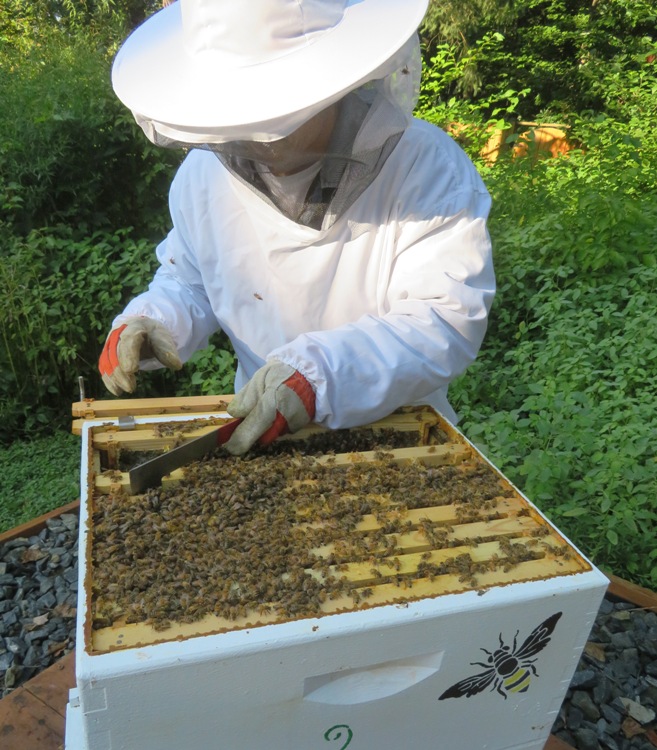
Here are the rest of my pics. I believe all are from the south hive. I'm still having a hard time keeping the smoker lit. I need to read up on that. I keep putting that off.  |

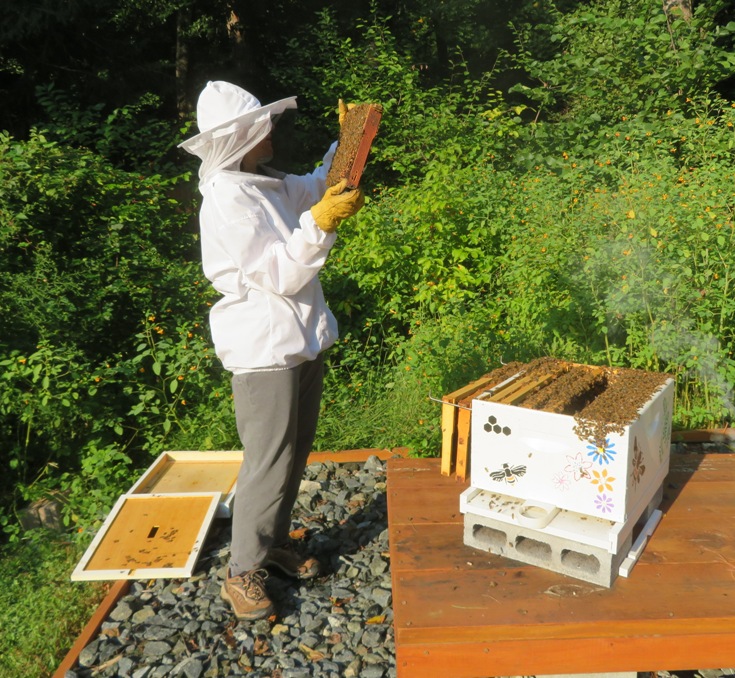
|
I checked my bees for varroa mites.
Varroa mites are tiny red-brown external parasites of honey bees. Although varroa mites can feed and live on adult honey bees, they mainly feed and reproduce on larvae and pupae in the developing brood, causing malformation and weakening of honey bees as well as transmitting numerous viruses. - from Bee Aware - Varroa Mites There are a few different ways to check for mites. I was told that the alcohol wash method was well suited for this area so I went with that. One drawback to the alcohol wash is that bees must make the ultimate sacrifice to help protect the rest of the colony. Before getting started, I found this strange-looking dead bee that looks like it didn't quite mature properly before it left its cell. Maybe it was a victim of varroa mites. 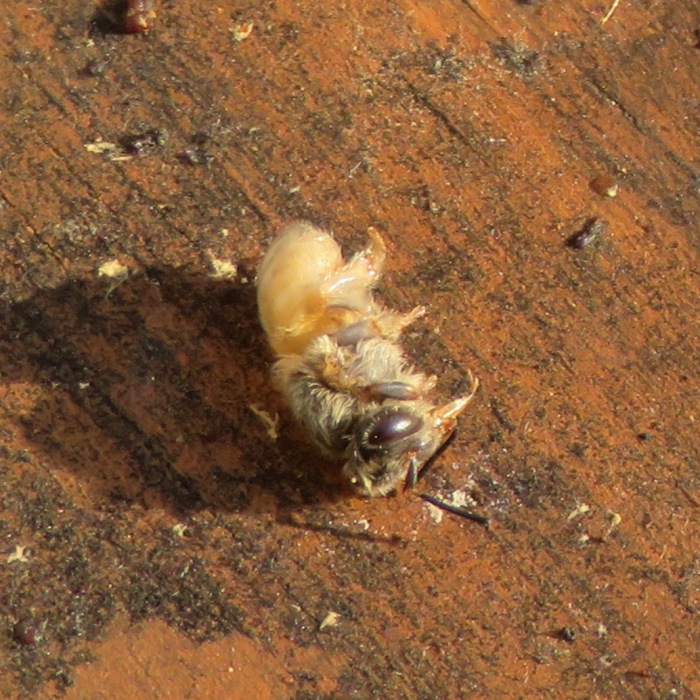
In this blog's cover photo Norma checks a frame from the south hive for bee larvae. Since the mites attack the larva, the adult nurse bees that tend to them will frequently be hosts. Those bees are the ones we want for testing. While inspecting the frames, I found eggs in both the south and north hives. 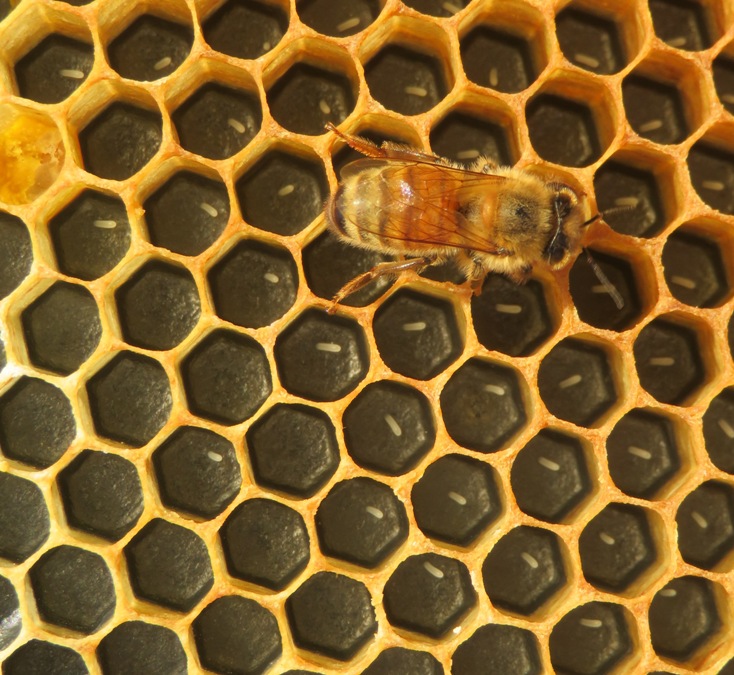
In the south hive, I found this queen cell. 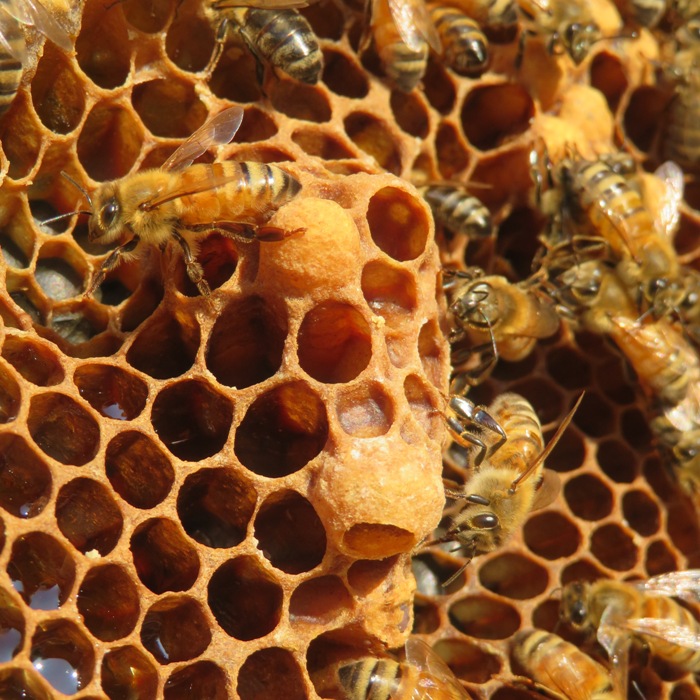
After selecting a suitable brood frame for testing, both Norma and I carefully searched for the queen. We don't want to put her in the mite wash...she is too valuable. Next, I shook the frame to make the bees fall into this plastic container. Then we collected a half-cup sample of bees (~300). This was our first time doing a mite wash so we did a very rough approximation. Measuring bees is not like measuring flour. 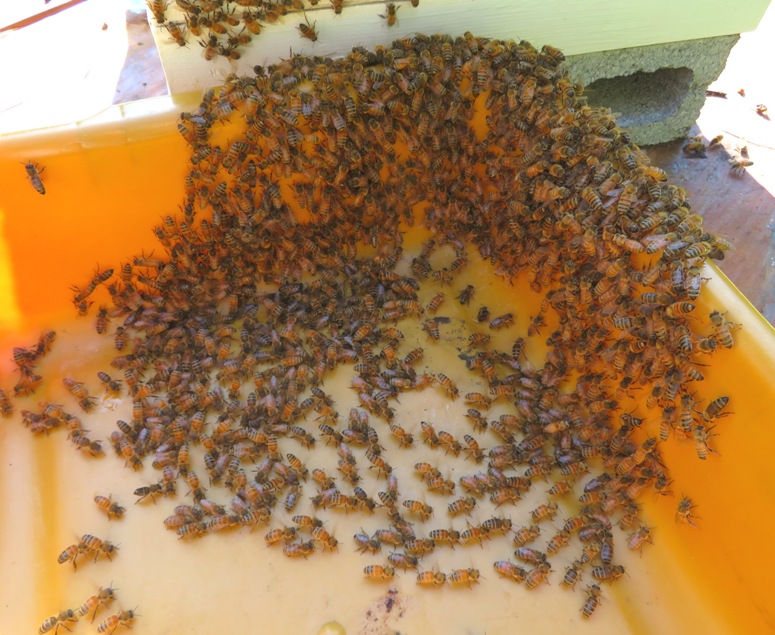
The mite wash involves shaking the bees in alcohol, which causes bees to die and the mites to release, which then sink to the bottom of the container. 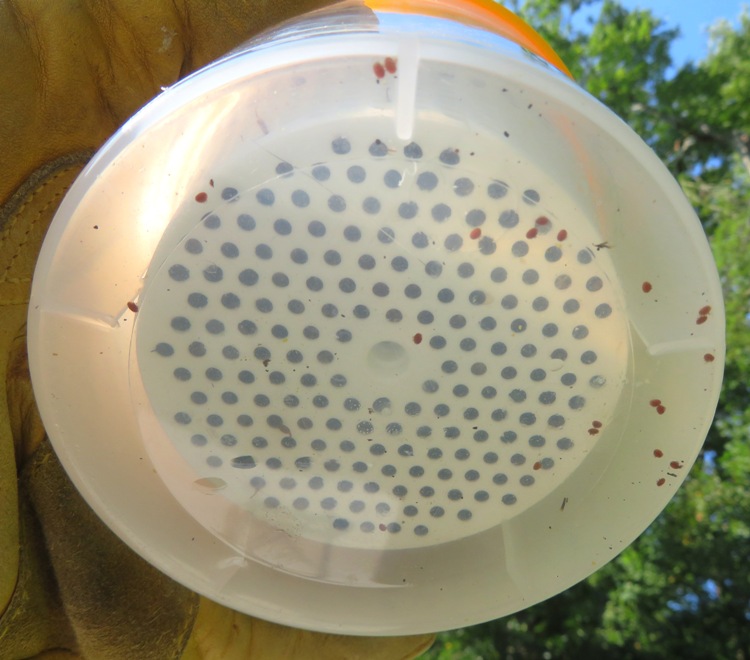
Here's a close-up of some mites. I knew there were enough mites to warrant treating the hive. They say that if you treat one hive in an area, you should treat them all. So I didn't bother testing the north hive. It would be treated regardless of the outcome. 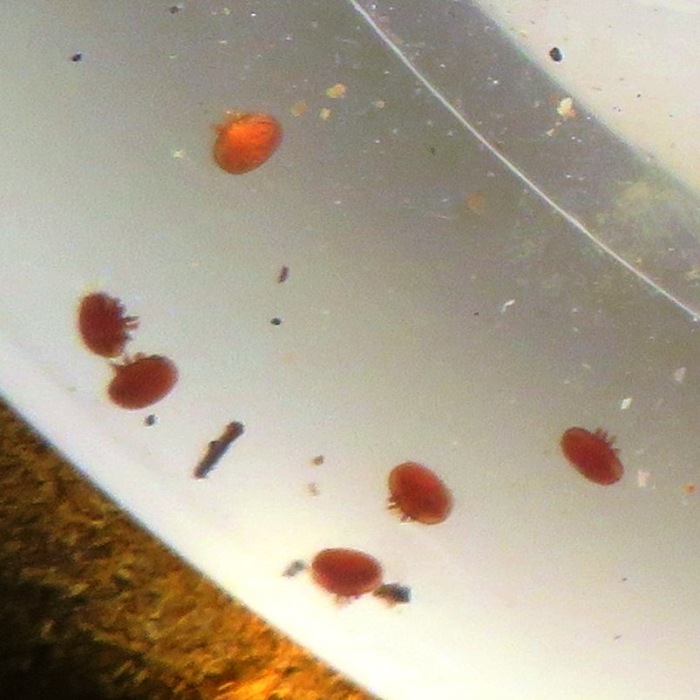
Inspecting the north hive, I found some frames have cells that look thick and black. This was much more common in the north hive than the south. I read a possible answer at Honey Bee Suite - Who Do Brood Combs Turn Black?: The color found in the dirt and debris, combined with the layers of propolis - which is usually dark - probably accounts for most of the color change. 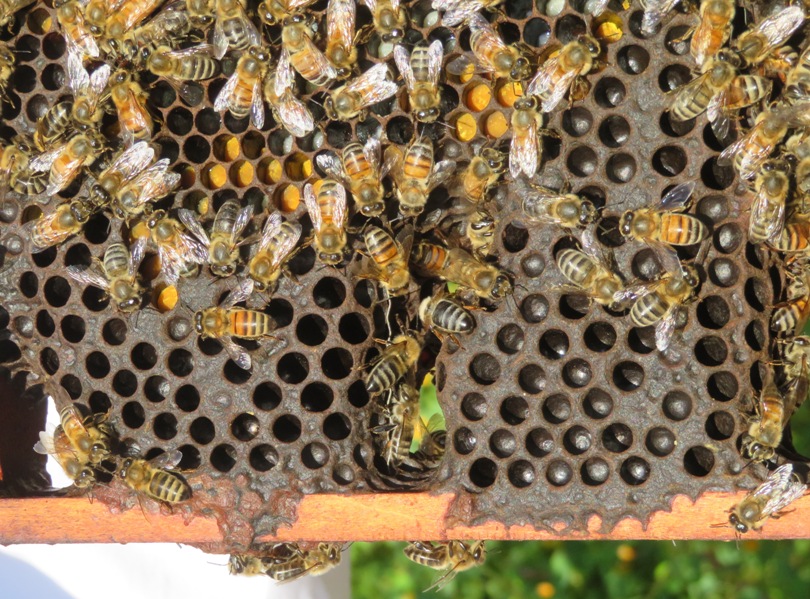
I found plenty of larva in different stages of development in the north hive. There seemed to be less activity on the north side of the north hive. There were significantly more frames without comb. I wonder if it is because the north side is colder. 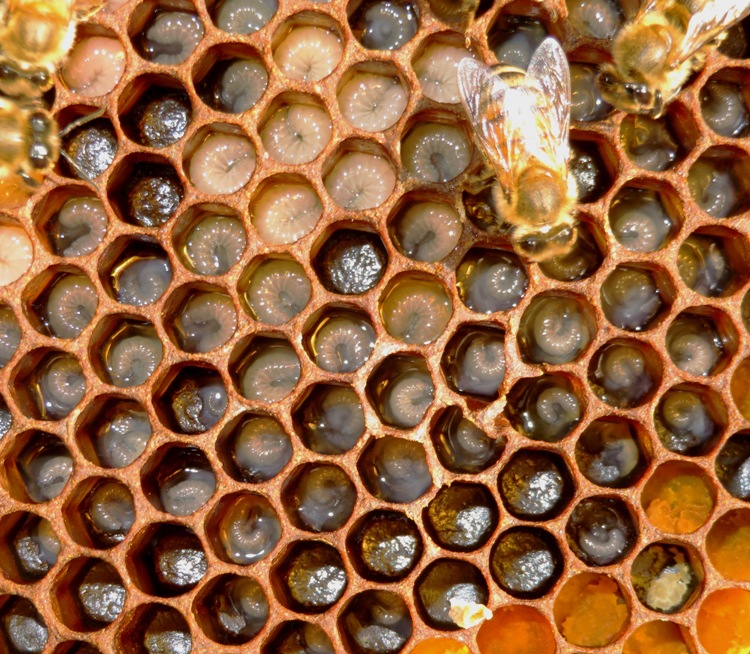
In the upper left corner, you can see a small hive beetle. If you look really close, just above the beetle, you can see a mite. I saw quite a few small hive beetles in the north hive. The small hive beetle can be a destructive pest of honey bee colonies, causing damage to comb, stored honey, and pollen. If a beetle infestation is sufficiently heavy, they may cause bees to abandon their hive. Its presence can also be a marker in the diagnosis of colony collapse disorder for honey bees. The beetles can also be a pest of stored combs, and honey (in the comb) awaiting extraction. Beetle larvae may tunnel through combs of honey, feeding and defecating, causing discoloration and fermentation of the honey. - from Wikipedia - Small Hive Beetle 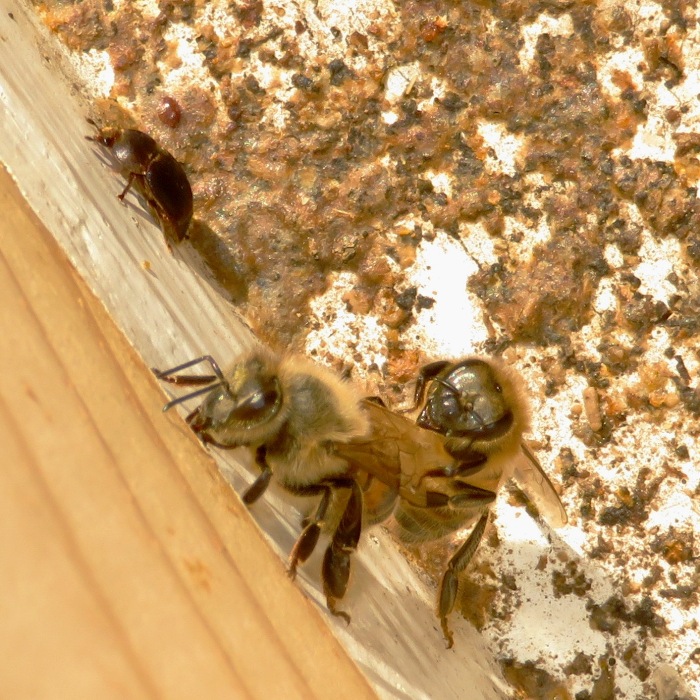
In the north hive, I found the queen. Notice how her abdomen is extremely long and her wings are short. She still has some white paint on her from when she was marked. She is the original queen of this colony. On this particular frame, many of the cells were askew, like the Leaning Tower of Piza. 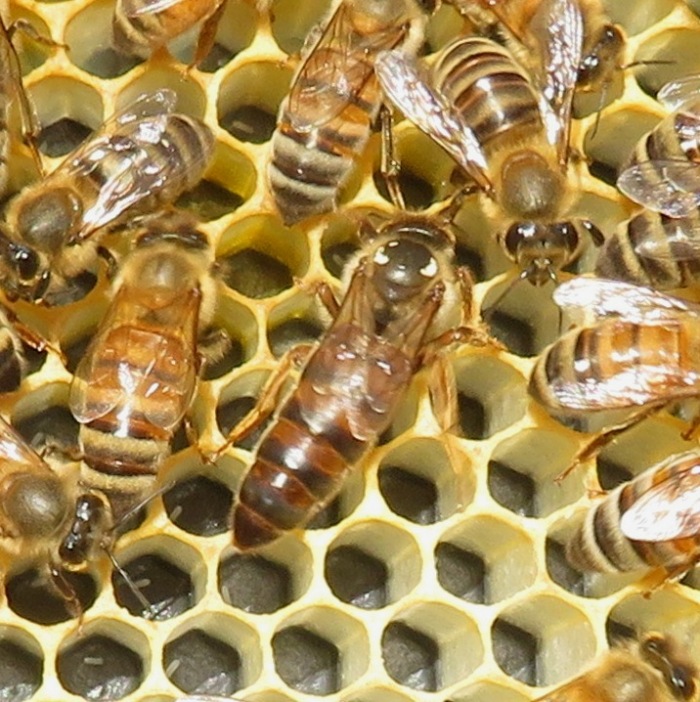
Here are the bees that gave their lives for the rest of the colony. It was a lot easier to measure the volume of these bees after they are dead. I estimate that I collected 475, which is far more than I needed. They yielded a mite count of 22 (4.6%). Three percent is the threshold for treatment. So I need to treat. 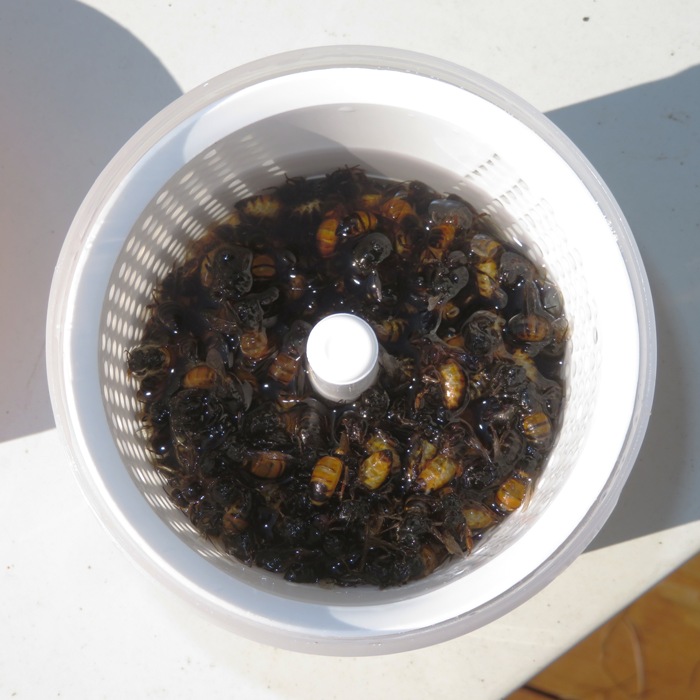
Once the daytime high temperature drops to 50-85 degrees for at least three days straight, I can apply formic acid strips to kill the mites. So I won't be treating them anytime soon. But at least now I know they need to be treated. I got stung in the elbow. Norma didn't get stung. After checking the hives, I climbed up onto the roof of the shed to check my bat boxes. No signs of any bats taking residence there. As far as I know, no bats have ever lived there. Looking down from the roof, I had this view of my hives. 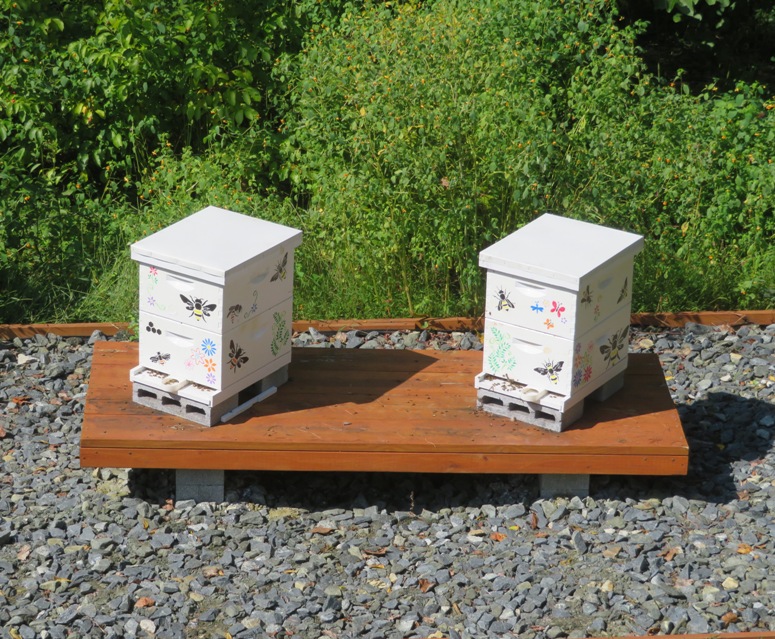
 |

|
Recall that on September 11, 2021, Norma and I tested the south hive for varroa mites. The ratio of mites to nurse bees was 4.6%. Anything above 3% in this area needs treatment. So on September 14, Eric Malcolm came by and applied a chemical to kill the mites.
I purchased formic acid strips to kill the mites but the temperature for the next several days would have been too high for application. So Eric treated them with oxalic acid dihydrate...something more commonly used by professionals. For this, he used a ProVap 110 to heat up the powder and then blow it into the hives. This chemical is safe for bees, toxic for varroa mites, and dangerous for humans and animals when applied because it causes a burning sensation in the eyes and should not be inhaled. But Eric had the proper protective gear to apply the treatment. I maintained a safe distance. 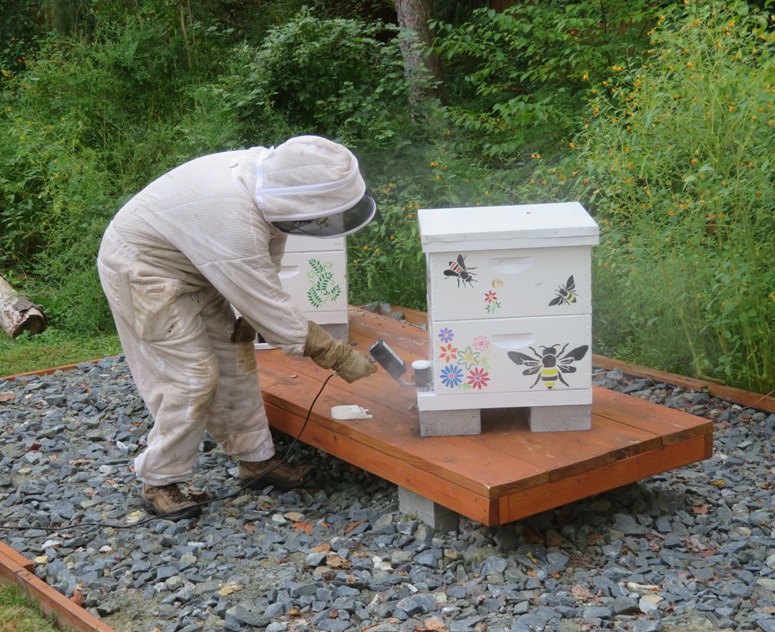
Eric uses a generator to power his applicator. 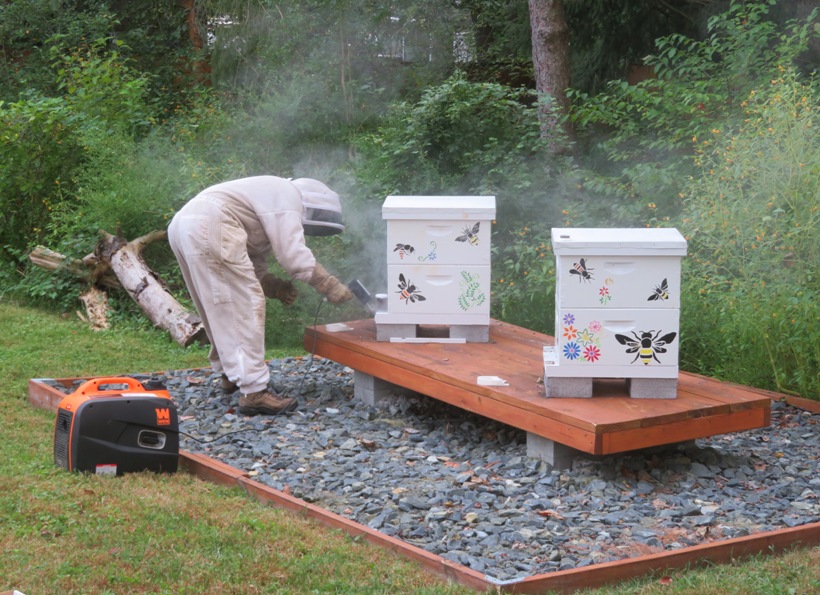
Once the temperature cools down, I plan to apply formic acid to help kill any remaining mites. Formic acid is good because it can treat the mites living on pupae in capped cells. Many other mite pesticides cannot do that. In the future, I will consider purchasing and applying Apiguard to treat the mites since this is not temperature-dependent. Later that evening, I fed the bees sugar water (1:1 ratio) and gave each hive some pollen patty to help boost brood production. I also killed about 16 small hive beetles with my hive tool. They are often found under the telescoping cover. I expect I will be doing that quite frequently for a while. Eric pointed out a wax moth at the entrance of one of the hives, which I promptly killed. These are bad too. There are so many things that can do wrong in a bee colony; it can all be overwhelming. But the varroa mites are the biggest problem in this area so for now, I will focus on that. I checked things on the evening of September 15. Within less than 24 hours, each hive consumed a full quart of sugar water. I checked the telescoping lid and inner covers for hive beetles again. I found five on the south hive and none on the north. That compares with 16 total that I saw yesterday. I suspect many of the hive beetles migrated to the top because they didn't like the oxalic acid which was coming in from the bottom. I figure I'll keep checking the hives (at least the lid/cover) for hive beetles over the next several days.  |

|
I manually killed about eight small hive beetles. On the previous day, I killed about ten. These numbers are too high. But for now, I need to focus on the varroa mites.
The high temperature on that day was supposed to be 82. The highs over the next two days would be in the 70s. No rain was expected for three days. Green light for application. I removed the remaining pollen patties, boardman feeders, and jars before laying down the formic acid strips. I put Swiffer sheets on top of lower boxes (unscented, dry). I applied a single sheet for each hive with the dimple side up. This is to catch small hive beetles. I also sprinkled diatomaceous earth (4 pounds food grade) under and around hives. This is to kill small hive beetles. One nice thing about my setup is that anything that crawls must get to the hives via the cinder blocks. There is no other way. 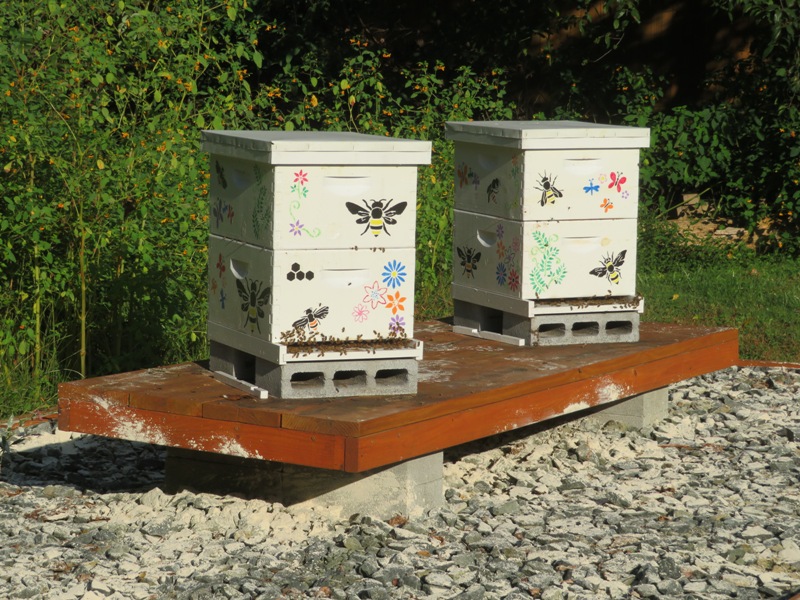
After applying the formic acid, lots of bees congregated outside of the south hive. Can't blame them. I wouldn't want to stay in my house if it was being fumigated. 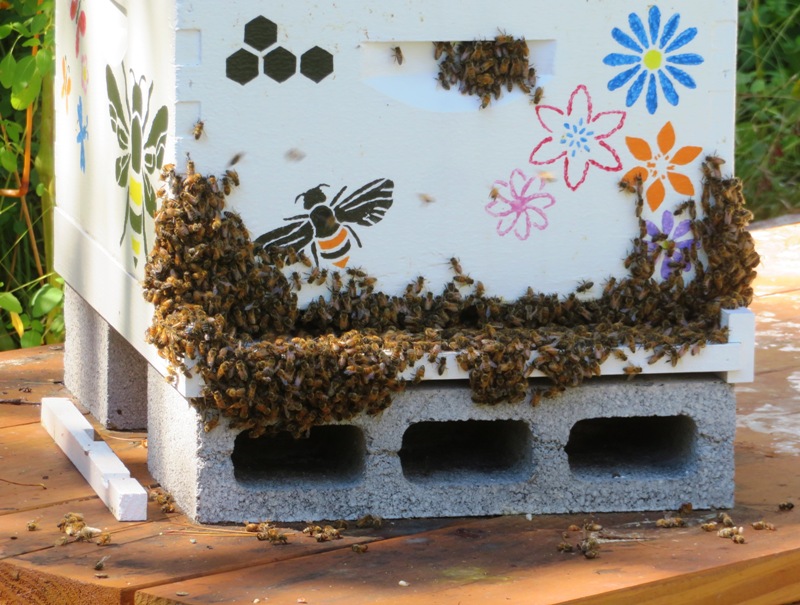
 |

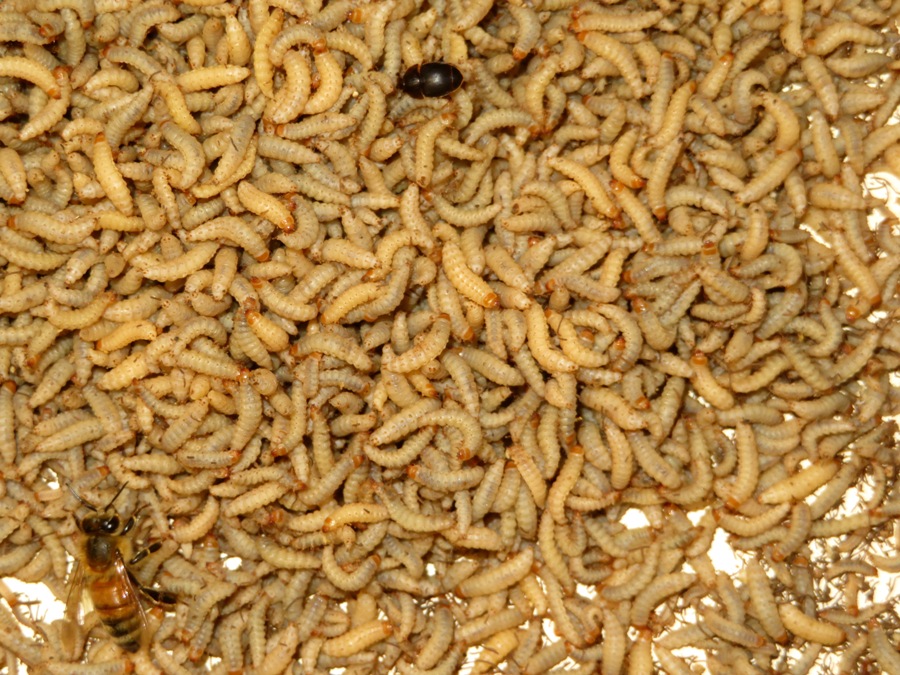
|
This was, without a doubt, the worst day of my beekeeping experience. When I opened up the north hive, I saw several hundred small hive beetle (SHB) larvae on the bottom board.

I removed the hive boxes and then poured a whole bottle of alcohol on the SHB larvae, away from the hive area. Then I rinsed and scrubbed the bottom board. I later thought that I should have tried to feed them to the chickens. But maybe it is best I didn't since the chickens can be messy eaters and end up flinging live larvae into the lawn where they could get away. I'm pretty sure that the way I did it, they are all dead. I went through all the frames and killed any SHB adults and larvae I could find. 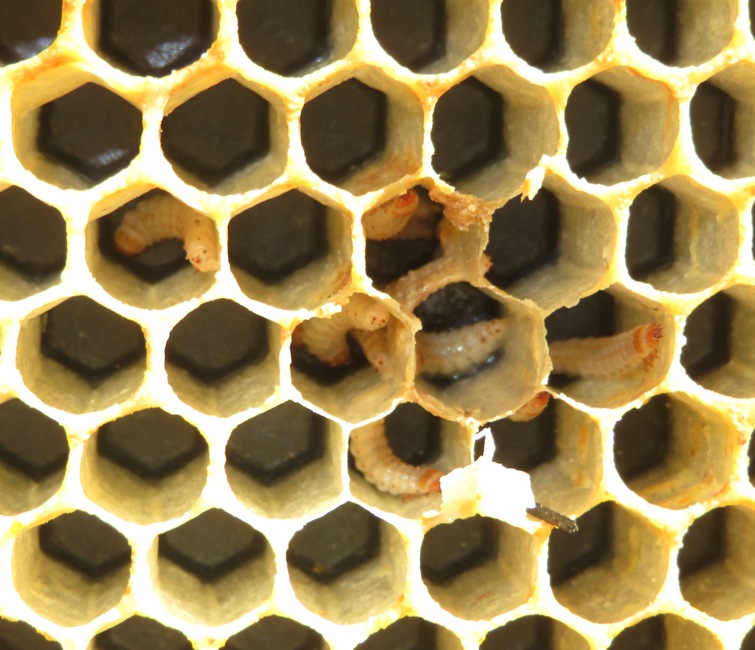
This was all in the north hive. I didn't see any SHB larva in the south hive. The south hive has about twice as many bees as the north hive. The SHB infestation explains the low numbers in the north hive. It is a problem that often only gets worse until a beekeeper intervenes. A strong hive will be able to handle the problem itself. But a weak hive just doesn't have the numbers to deal with it. I think of SHBs as shoplifters in a store. Imagine that the bees are the store workers. They have a lot of work to do: stocking shelves, taking inventory, dealing with customers, etc. But if you have shoplifters, then the store workers need to keep them away. That takes resources away from the workers maintaining the store. So the store can't make as much money and thus, cannot hire enough workers. Without enough store workers, the shoplifting gets worse. Eventually, the store goes out of business unless something can be done. Today, I was the cop that came through and dealt with the hoards of shoplifters. Hopefully, I wasn't too late. Swiffer sheets can work well to catch adult SHBs. Bees chew them up and beetles get stuck on them. 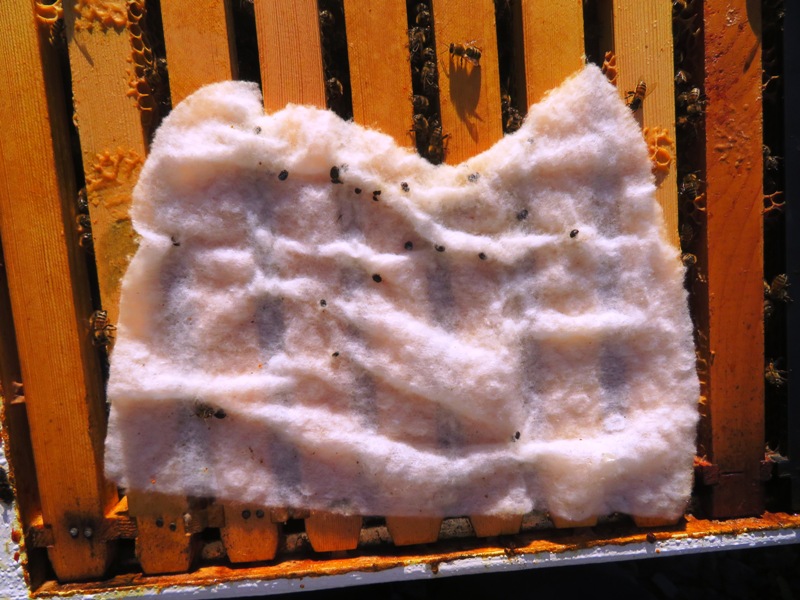
I was using full sheets but Eric said I should cut them in half (short cut, not long cut). Don't do like I show below. 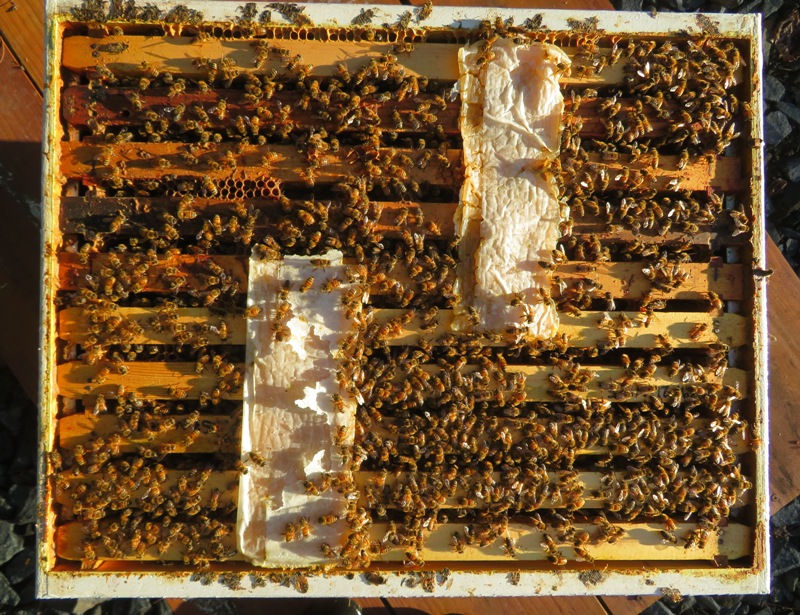
In the south hive, I found a frame loaded with honey. 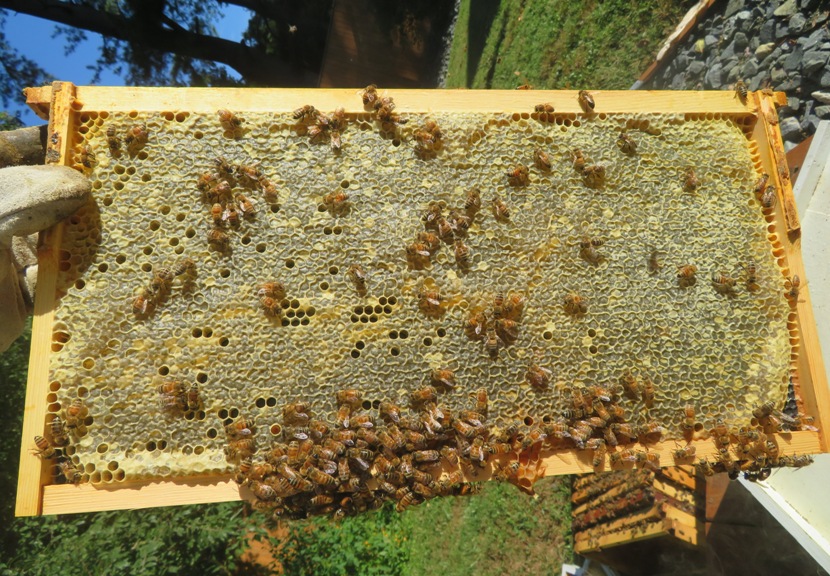
I found a capped queen cell in the south hive. 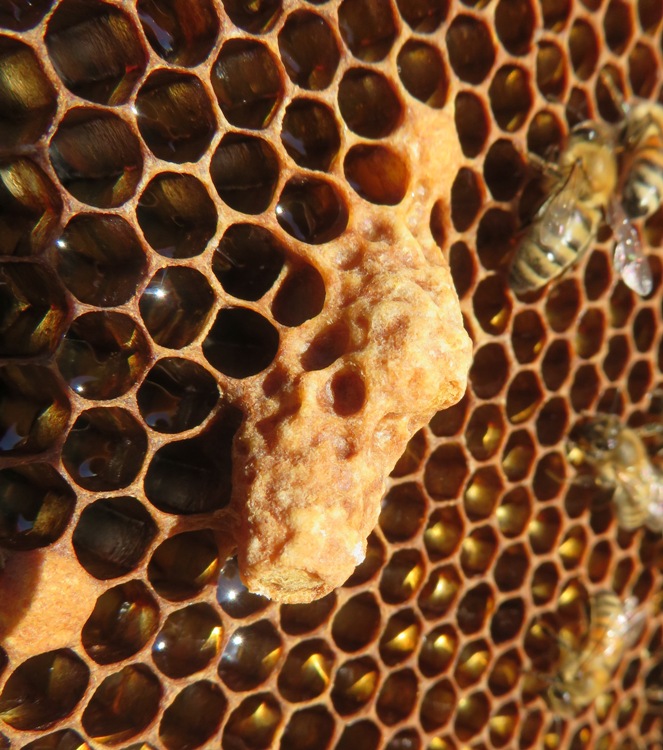
No eggs or bee larvae seen in either hive. I saw this young adult emerging from its cell. It may just be one bee but it is a symbol of hope for my hives. 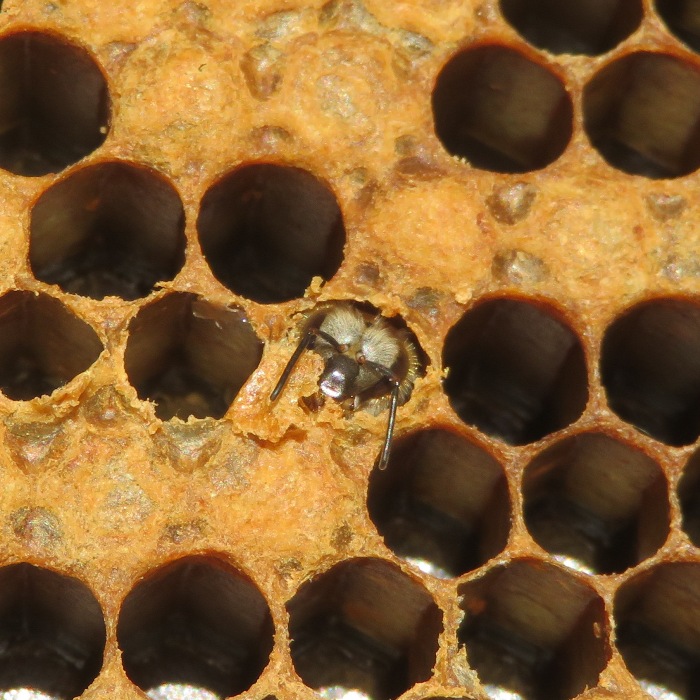
 |

|
The Swiffer sheets are still catching small hive beetles (SHBs). That is good. I replaced them with fresh ones. Unfortunately, some bees also get caught up in them and die. But I feel that as long as more SHBs die, then it is good for the hive.
I checked both bottom boards. Only a few live (less than five) SHV larvae were found in the north hive. None in south. No dead ones in south either. I found a few adult SHBs but their numbers are decreasing in both hives. I found bee eggs and bee larvae in south hive. I did not find any in north hive but I did find a capped queen cell. I put her in the lower box facing an almost empty frame so she would have plenty of room. 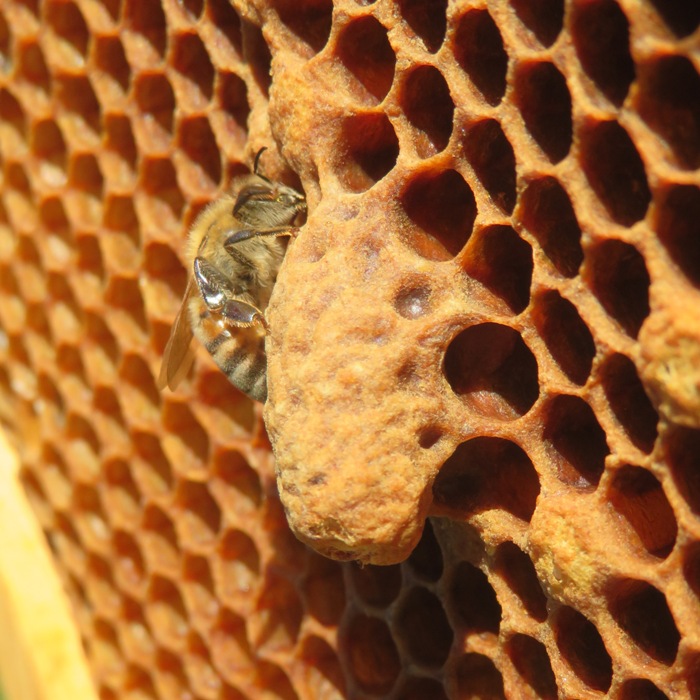
I moved two frames containing bee eggs/larvae from south hive to north. I am thinking that the queen in the north hive might have died from the mite treatment. It isn't unusual for the weaker bees to die during such treatment. Four days prior, I removed three frames from the north hive that did not have brood and had very little honey, nectar, or pollen. I wrapped them in a garbage bag and put them in the freezer. Freezing them like this kills SHBs. Removing the frames from the hive means there is less real estate for the bees to guard. Recall the shoplifting analogy I gave. Given the same number of store employees, it is easier to keep shoplifters out of a small store than a big one. I took the frozen frames out of the freezer this morning. There were some SHB larva that had hatched and then froze/died. I put these frames in the garage. I removed three more frames and froze them. I am doing three at a time because we don't have enough freezer space to do more. I discussed feeding with Eric: I'd recommend finishing the treatment and then feeding 1:1 [equal parts sugar and water] until October. A 1:1 ratio simulates a nectar flow, so the queen should begin laying more (giving you more fall/overwintering bees). I'd check them for mites and inspect them once more after treatment. If you have light boxes still at that point, feed them 2:1 [two parts sugar to one part water] from there on until it starts to get cold. I did not check for mites again and I did not treat for them either. I felt the whole mite treatment thing is pretty traumatic for them so I'd rather not check or treat any more than necessary. A lot of beekeepers just treat when the time of the year is right. I might do that. Eric mentions the transition for switching from a 1:1 sugar water ratio to a 2:1 ratio. Around early to mid-October is when this should take place. Yesterday, I ordered four Pierco - 6 5/8" Medium, Two Frame Feeder, 1 Gallon - With Cap & Ladder. I plan to use two in each hive with the medium box to feed my bees sugar water at 2:1 ratio. They have been consuming a tremendous amount of syrup lately to prepare for the winter. It isn't unusual for them to go through a full quart jar in 12 hours! It is an inconvenience to have to suit up and refeed them so frequently so I figure that bigger feeders might be the solution. Since these Pierco feeders go in a hive box, they would be more resistant to robbing. Do I really need to suit up just to change a quart jar of sugar water? Yes. The worst sting I've ever gotten was when I was removing a supposedly empty jar. I think some of my bees have food aggression. Ever since then, I suit up.  |

|
On October 1, I ordered four Pierco - 6 5/8" Medium, Two Frame Feeder, 1 Gallon - With Cap & Ladder because the bees were consuming a quart of sugar water per day. Frame feeders seem like a more efficient way than entrance feeders to feed bees a lot of syrup. It recently arrived and I was eager to try them out.
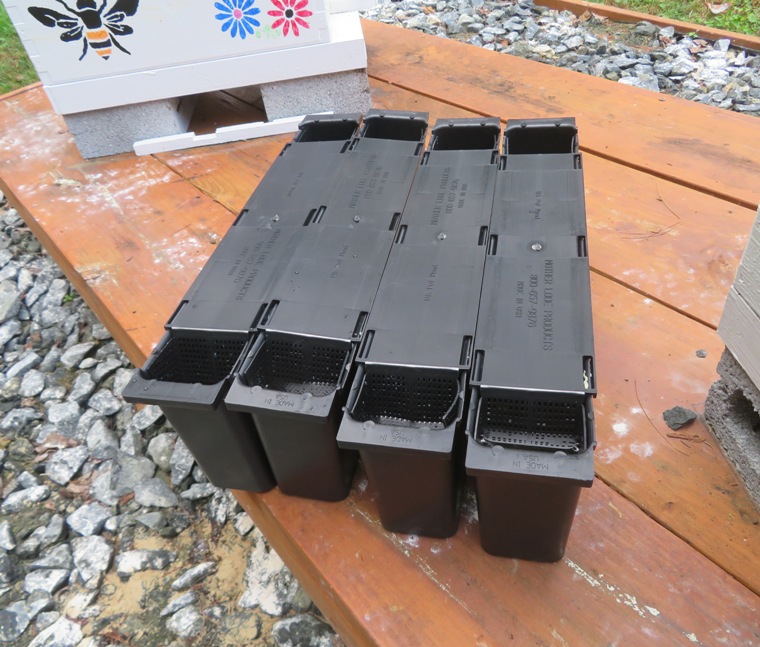
I added a medium box on each hive and put then two of these feeders in each. That means I could feed each hive up to two gallons at a time! 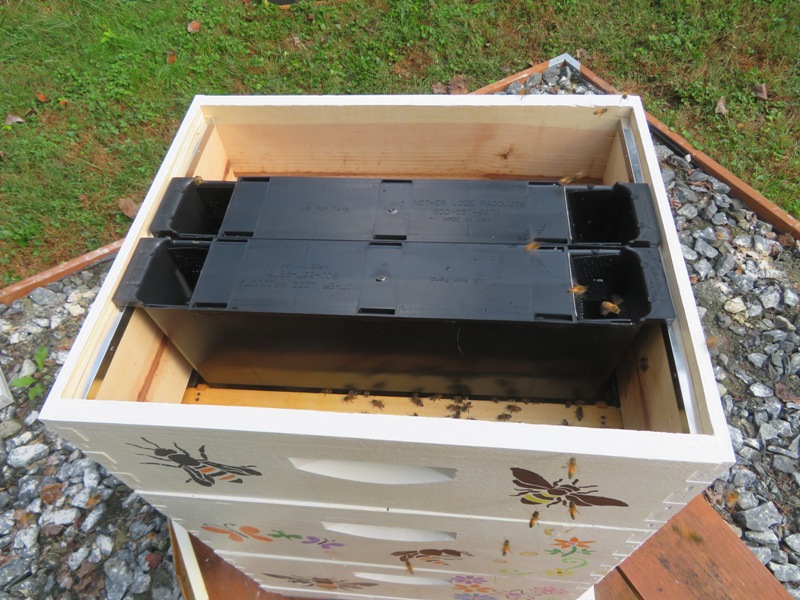
It takes a lot of sugar to make this much syrup, especially since I am feeding them two parts sugar to one part water (2:1 ratio). It also takes a lot of energy to heat up the water so the sugar dissolves. I know that honeybees are good for the environment but I have to wonder what the net effect is on the environment after purchasing all the equipment and supplies, the transportation for delivery, making sugar water, etc. Hopefully, my bees will be strong enough next year so I don't need to feed them so much. I am still hoping to see signs of a north hive queen. I see a lot of queen cells but still no eggs. This has me a little worried. 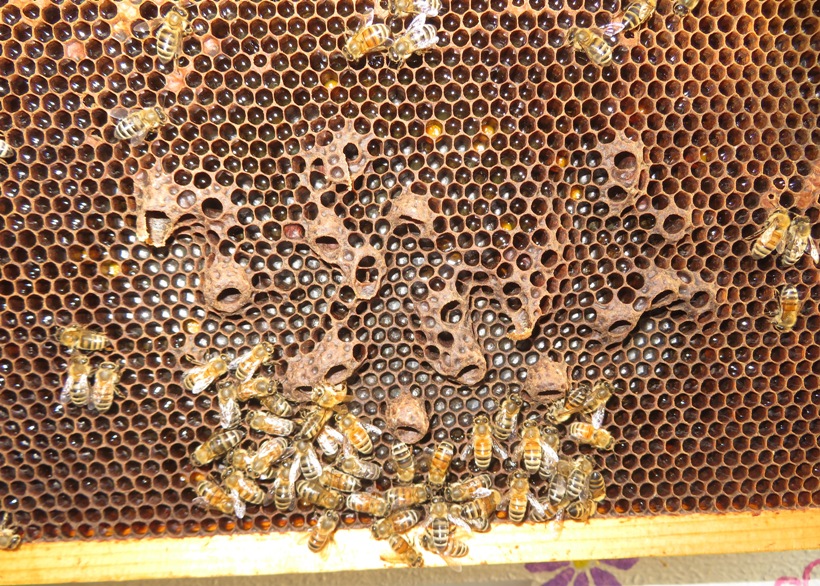
 |

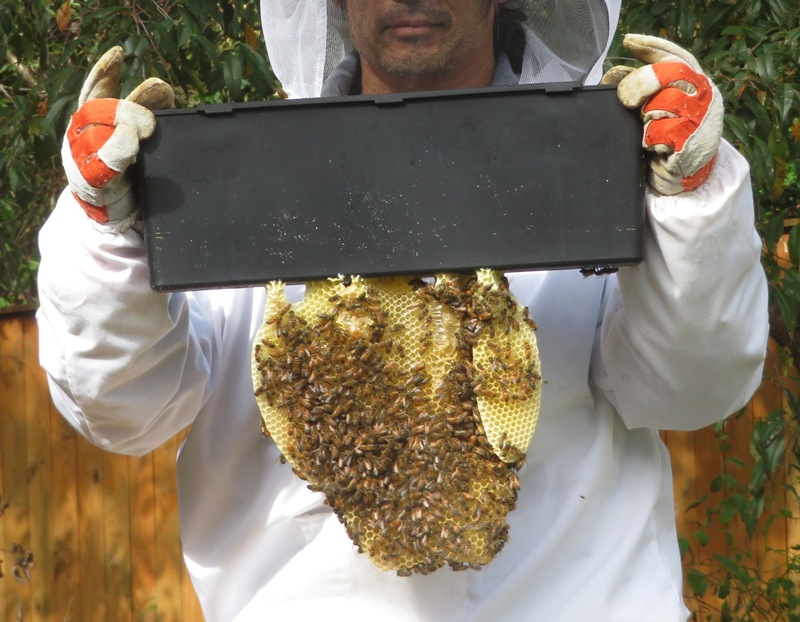
|
On September 28, 2021, I started removing empty (or nearly empty) frames so the bees would not have so much real estate to patrol for small hive beetles. I froze these frames for four days to kill any beetle larvae. That left a big empty gap in the hives. I put the frame feeders over this space. Instead, I should have occupied this space with the frame feeders. Why? Because the bees decided to fill the empty space with burr comb.
...in a Langstroth hive ([what I have]), burr comb, also known as brace comb and bridge comb, are portions of honeycomb built by the bees in other places than in the intended place in the frames. - from Wikipedia - Burr Comb 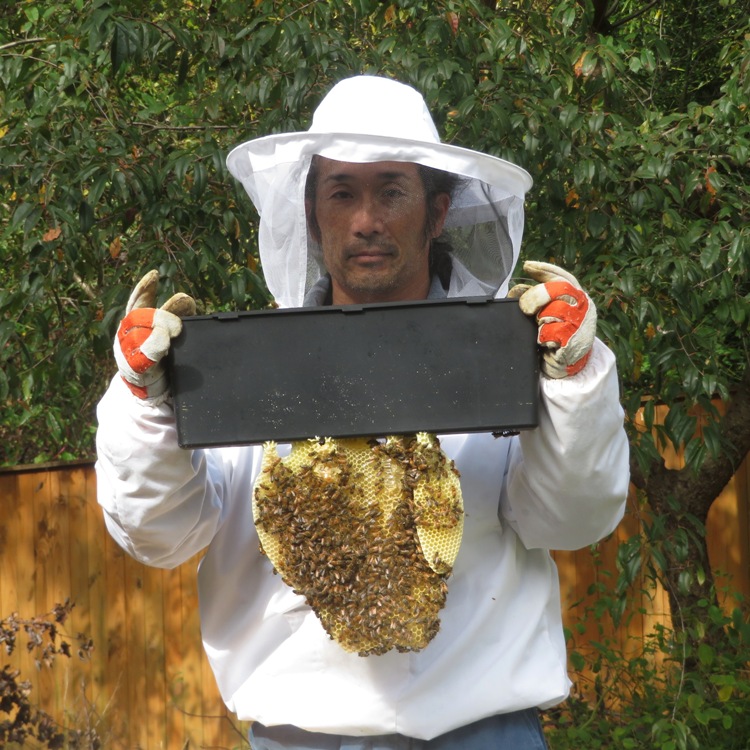
The bees naturally build comb perpendicular to a frame. But when a frame feeder is above and there is a big gap below, they attach the comb to the frame feeder. The really long comb attached to the feeder I am holding is from the north hive. 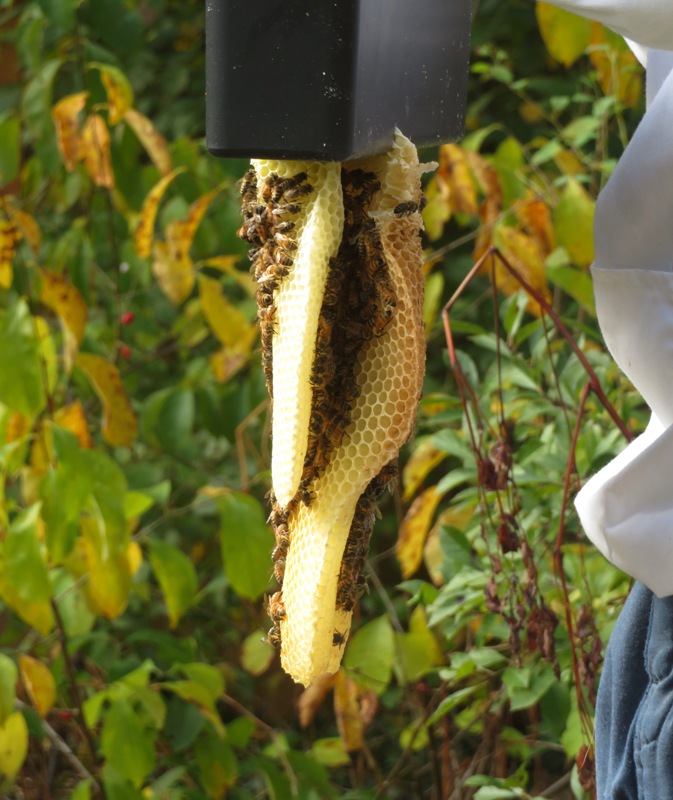
I removed the comb that was being built in places other than the frames. Fortunately, no brood was in there but a lot of sugar water was. I placed much of this comb on the platform so the bees could remove the sugar water. They worked pretty fast in doing so but there were also a lot of bees flying all over the yard because there was so much sugar water leaking out of comb that I removed...some honey too. I was worried that this might cause robbing. I stored the wax from the burr comb. Maybe someday I'll make candles out of it. Unless I have a very strong hive and want to gather wax, I don't think burr comb is a good thing because it drains resources. The bees spend a lot of time and materials to build comb. They could have been using it to make honey, take care of brood, or do other things to prepare for winter. I put frames back into the hives. I have 9 or 10 in each deep. Nine might be good because it may not give them enough room to build comb where it shouldn't be but might make it easier to remove frames. Of course that also means less real estate for the bees to patrol for small hive beetles. I was ecstatic to find eggs and larvae in the north hive. Recall that I was pretty sure that Bernice died during the mite treatment on September 19, 2021. I didn't think the hive would make it through the winter without a new queen. I was also concerned that with so many drones being kicked out of their hives in autumn, a new queen might not be able to find a mate. But that was clearly not the case. 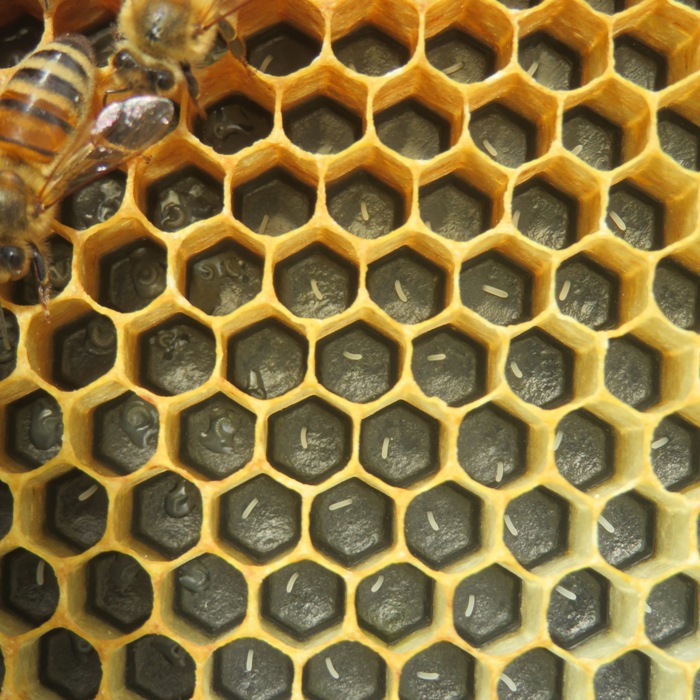
A couple months after taking the above photo, I zoomed in and noticed something I had never seen before. There were some really small larvae that had recently hatched. In a few cases, there were two larvae occupying the same cell. That means the queen laid two eggs in one cell! ...when a newly mated queen begins laying, she may lay more than one egg per cell. - from Wikipedia - Laying Worker Bee 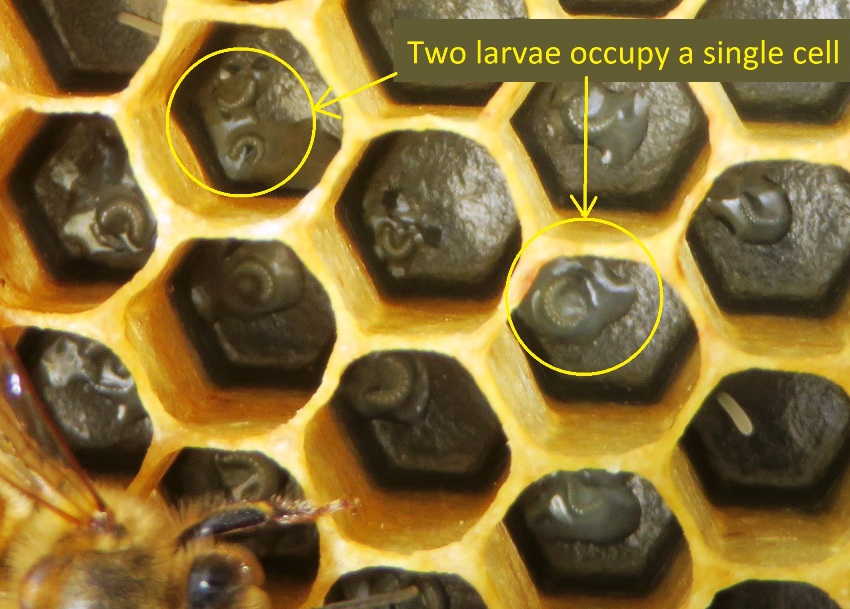
Eric wrote: When a new queen starts "learning" to lay, she can lay several eggs per cell. The workers come by to clean out the extras. Here are some older larvae from the north hive. 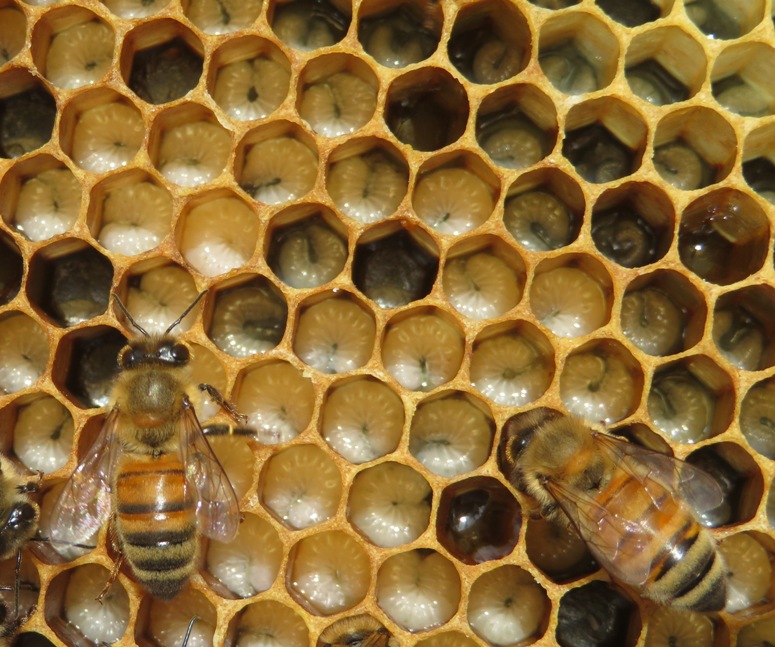
I found about 10 hive beetles on the south side of the lower box in the north hive. Swiffer sheets aren't collecting hive beetles anymore. Maybe it is because I put them on the frames in the top deep but that is no longer the top of the hive. So I moved them to be on top of the feeders.  |

|
I saw a few small hive beetles in the south hive but didn't find any SHB larva.
The south hive is packed to the gills with bees. Sweet! At first, I didn't find eggs in north hive but I saw a lot of larvae and pupae. Some of the larvae looked very small. But there were a good number of bees. The light was low so I took flash photography of brood cells and later verified that the north hive does indeed have eggs. I didn't check the south hive since it is SO full of bees. About six days after I first used the frame feeders (October 9, 2021), the feeders in the south hive were empty. In the north hive, they was about a third remaining. Bees aren't the best swimmers and some inevitably drown in the sugar water. But these frame feeders have a ladder on three sides to help prevent this. Still, about a dozen drowned. As of today, neither hive exhausted their sugar water supply. This surprised me because I gave that to them on October 31, which was 12 days ago. I think maybe with the colder weather, their metabolism is slowing. I had put up the entrance reducer on the north hive. Since their numbers weren't as great as the south hive, I thought they might be more prone to robbing. I was also concerned about them not being able to generate enough heat to stay warm. I had the entrance reducer set for the larger opening. For the north hive, the inner part of the telescoping cover (just above the hole in the inner cover) had mold. I soaked it with alcohol to kill it. I suspect that with all the moisture from the sugar water in the frame feeders and the less air flow, as compared to the south hive, this created high humidity and a breeding ground for mold. 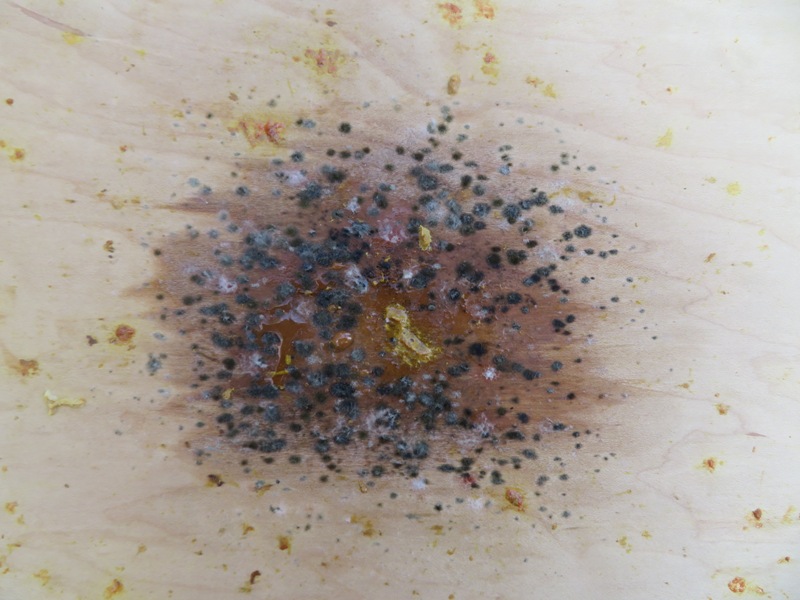
The south hive had no mold. So I removed the entrance reducer from the north hive to increase air flow. On November 12, I removed both feeders. There were a good number of dead bees in both (they drowned) and I figured that after 12 days, the sugar water probably was full of germs and needed to be replaced. I am trying to think of a better way to feed them that won't cause so many drownings. I am liking the boardman entrance feeders more but I know that is more prone to robbing and I don't like the idea of having to refill it so frequently. Maybe I should just buy more entrance feeders along with bigger jars.  |

|
Brian and I went in together to buy fondant from the Howard County Beekeepers Association (HCBA). This is their winter food supplement. He passed it onto me on December 4, 2021. I paid him $8 for two pieces of fondant, each about the size of a loaf of bread. On December 5, I fed a piece that was the size of about 2/3 of one of these "loaves" to the hives, giving about 2/3 of the piece to the south hive and 1/3 to the north hive. The south hive has about twice as many bees as the north hive. The temperature was about 50 degrees so I didn't keep the hives open for any longer than it took to place the fondant and remove the Swiffer sheets. The sheets are no longer catching small hive beetles and the beetles don't seem as much of a problem anymore.
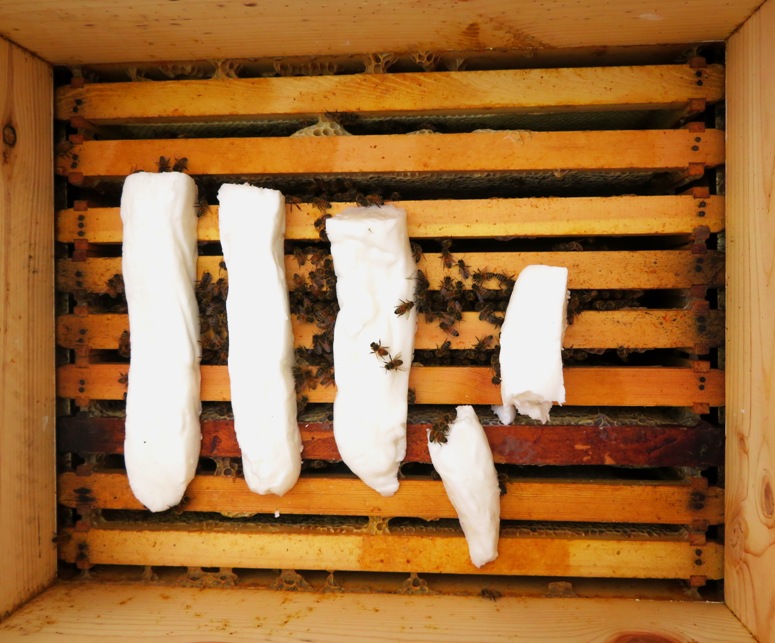
I shined a flashlight into the entrance of both hives. There are a lot of bees at the bottom of the south hive with few at the top. Conversely, there are a lot of bees at the top of the north hive with few at the bottom. I also noticed more black mold growing on the inner part of the telescoping cover of the north hive. Recall that on November 11, 2021, I supposedly killed this black mold with alcohol. This time I scrubbed it with soapy water to loosen things up. Then I dried it with a heat gun. I poured isopropyl alcohol on it and let it soak in for several minutes. Then I dried it again with a heat gun. Isopropyl alcohol is supposed to kill black mold. I did the same for the telescoping cover of the south hive, even though there was no mold...just being preventive. Note that I do not have the entrance reducer on either hive and have not been feeding the bees with the frame feeders for fear of high humidity that could grow mold. 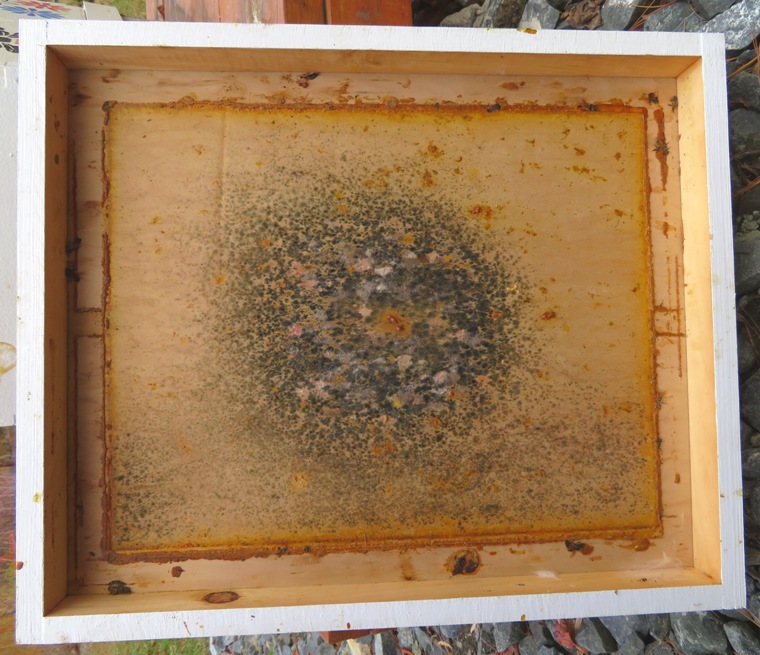
I filled up their boardman feeder jars. I won't be using these for much longer as I transition over to just using fondant. A couple weeks later, I checked things again. It was just barely above 50 degrees so I didn't want to keep the hives open for long. I just wanted to see if they were eating their fondant. Indeed they were. I'm guessing I'll have to replenish their supply by mid January. Hopefully, I have a warm day then to do that.  |